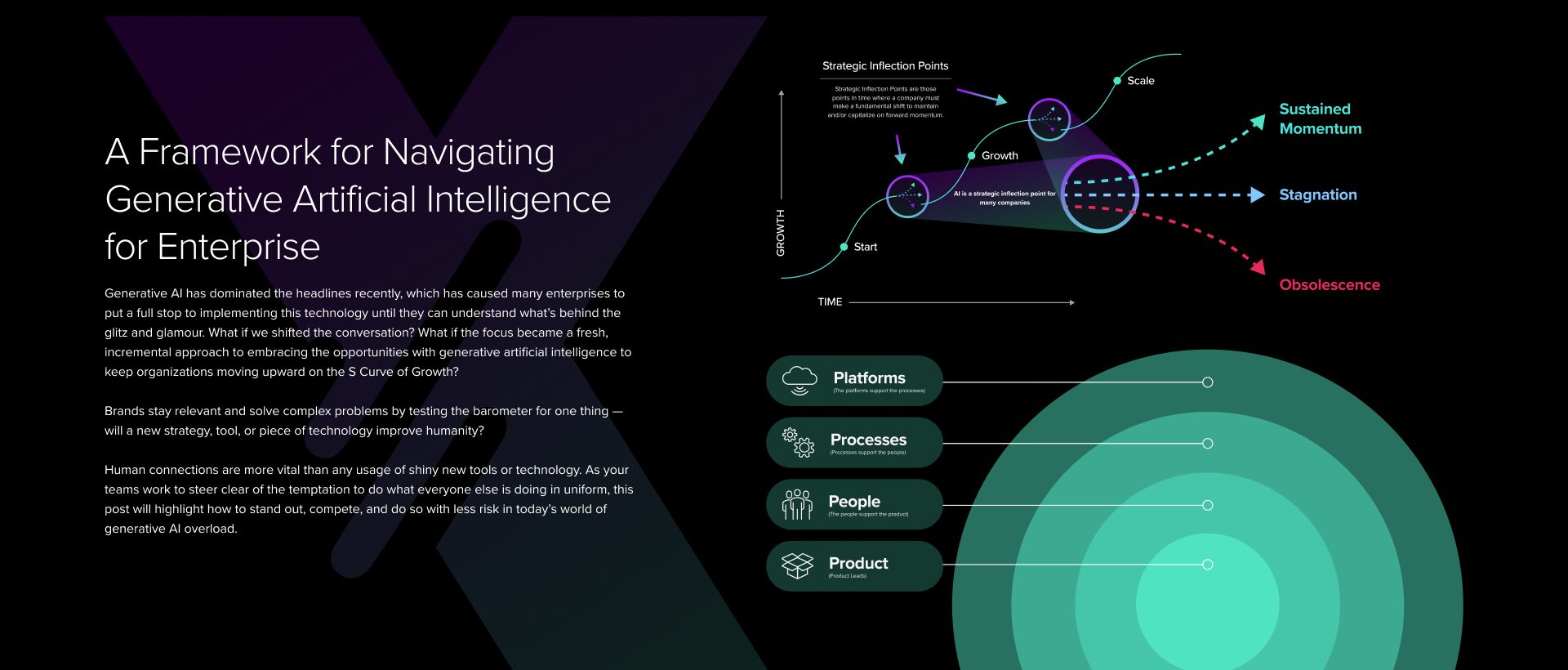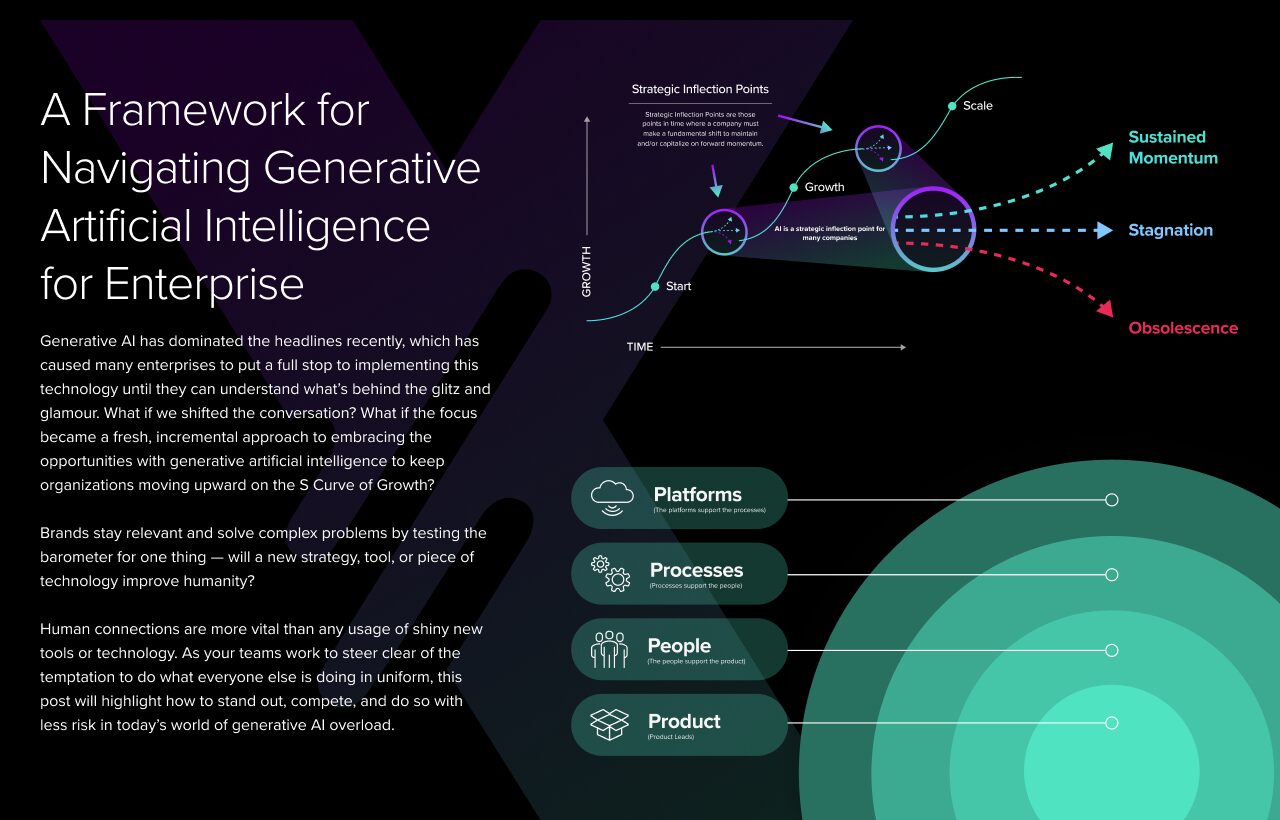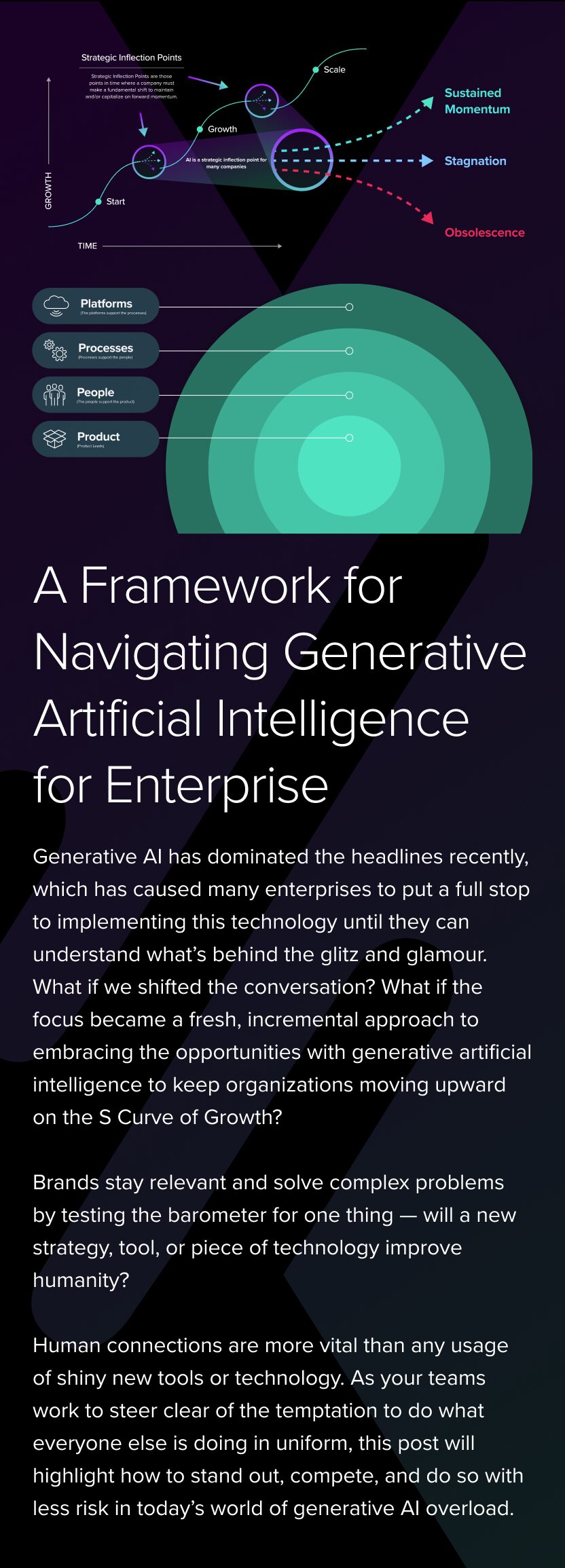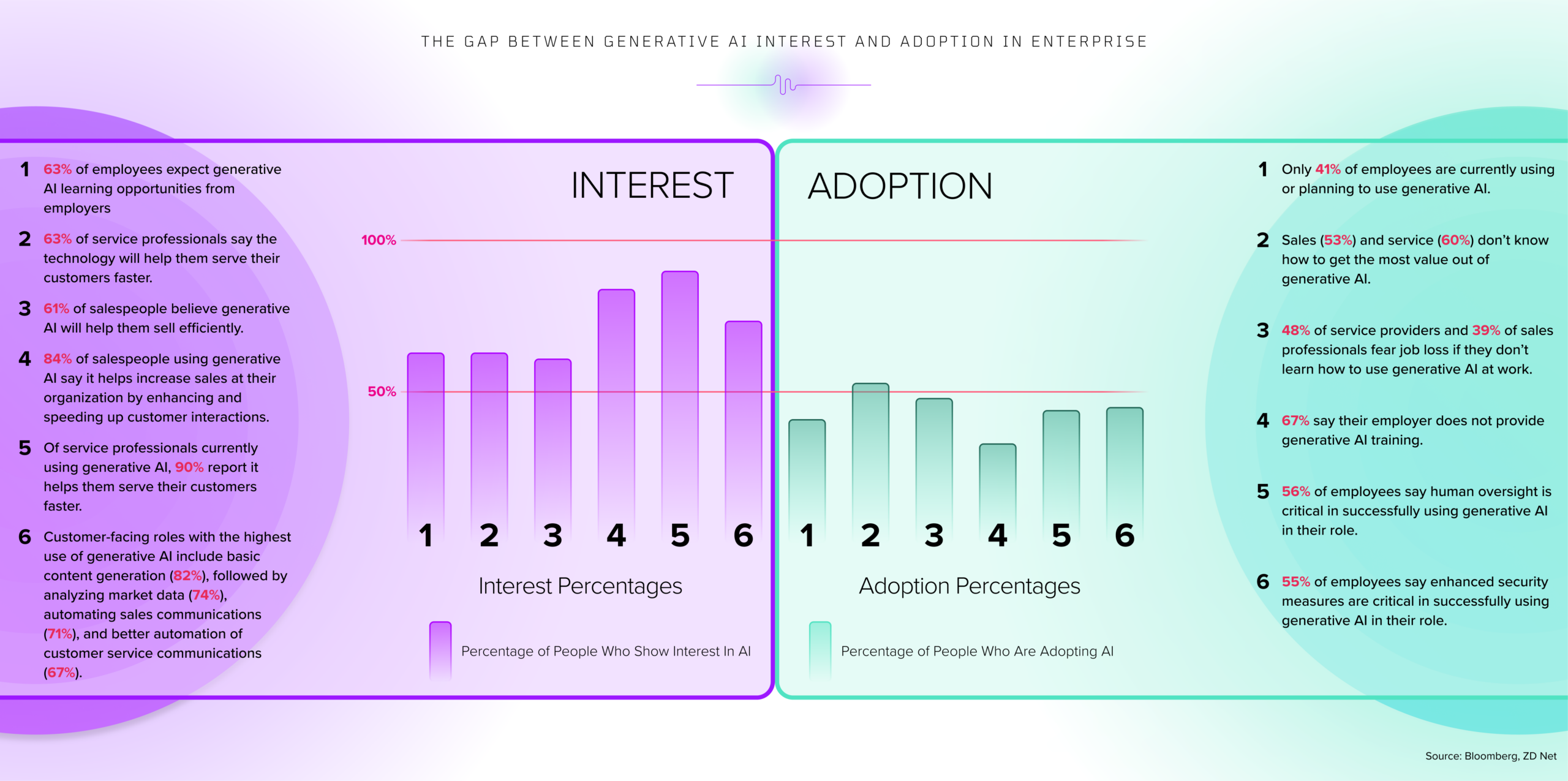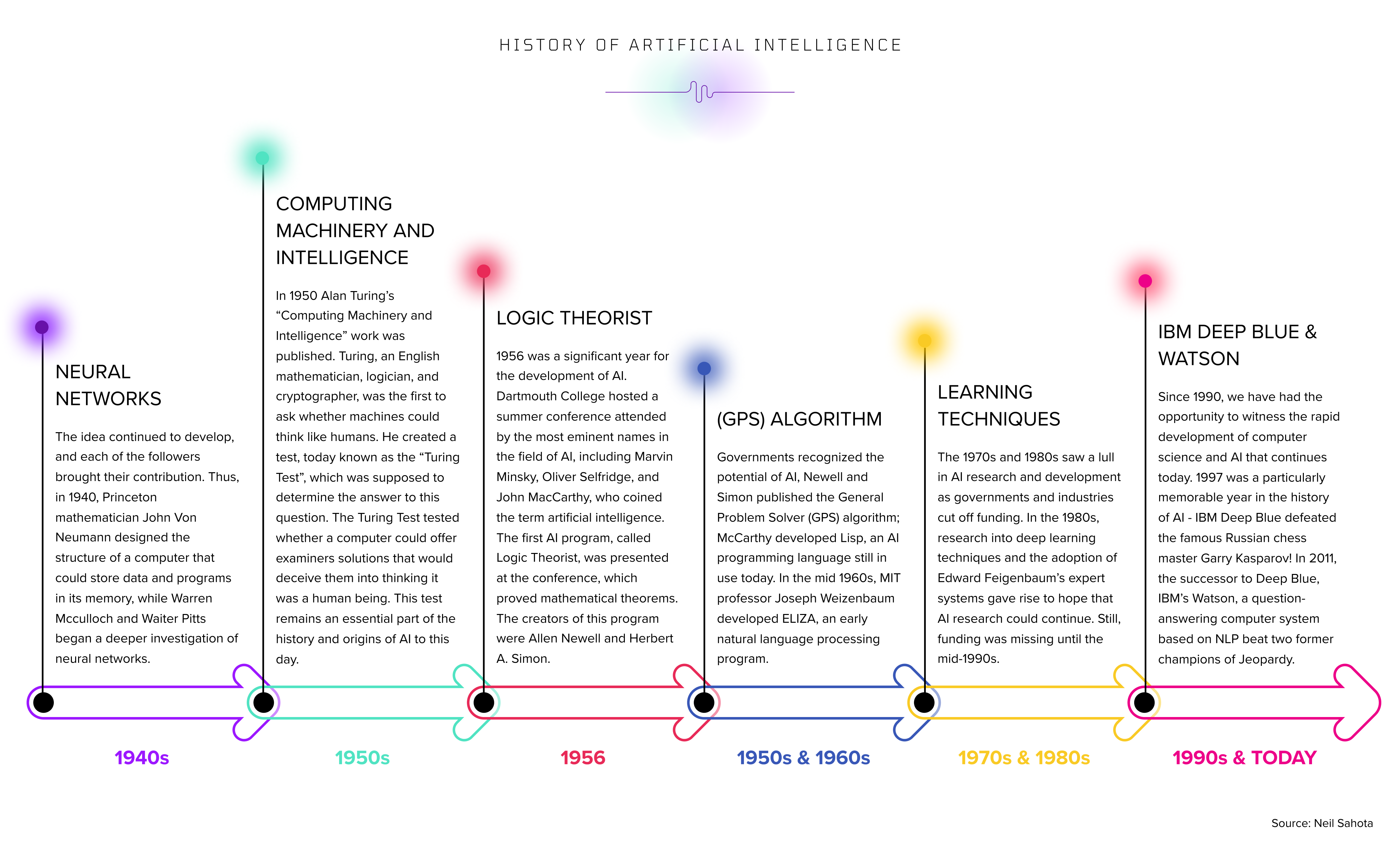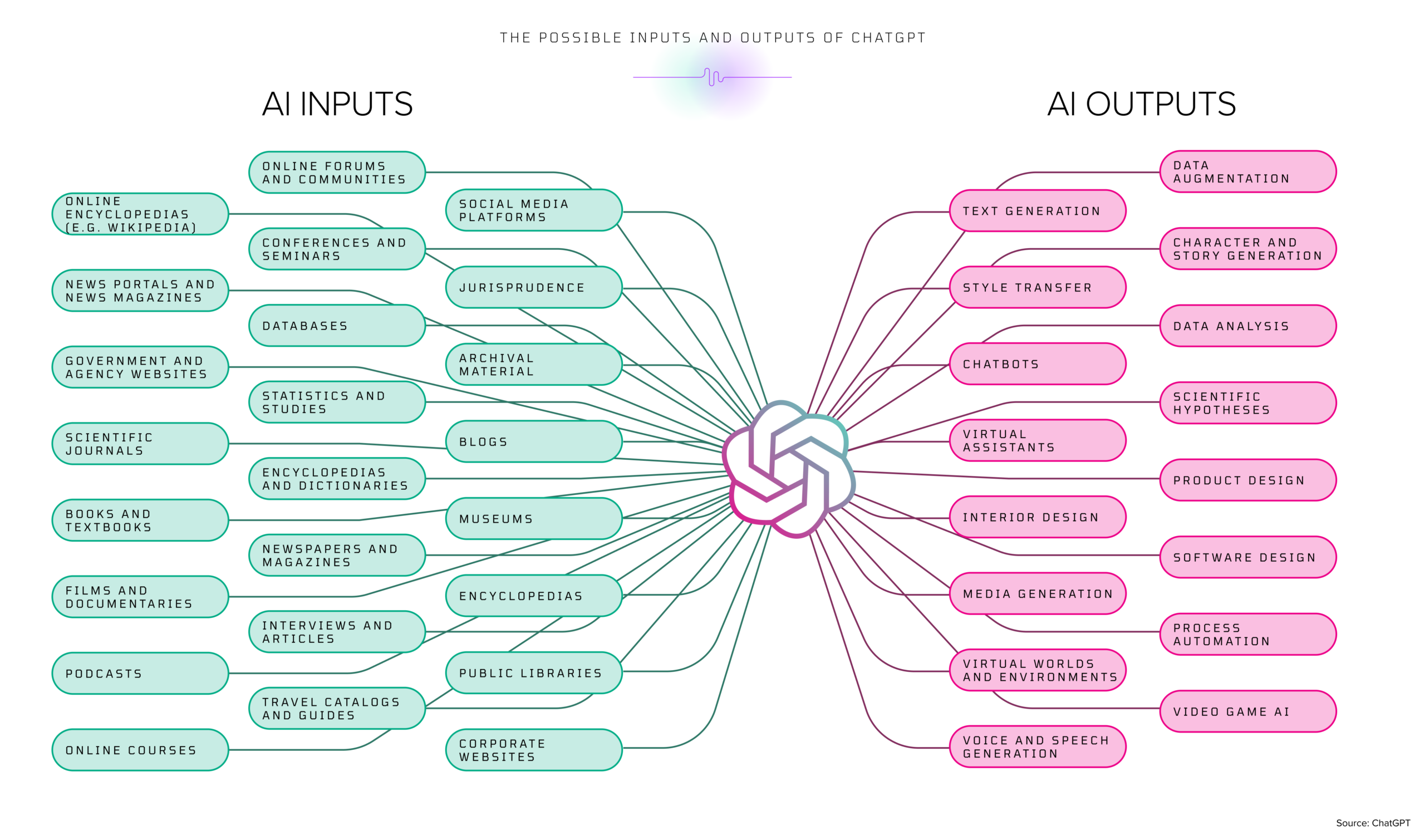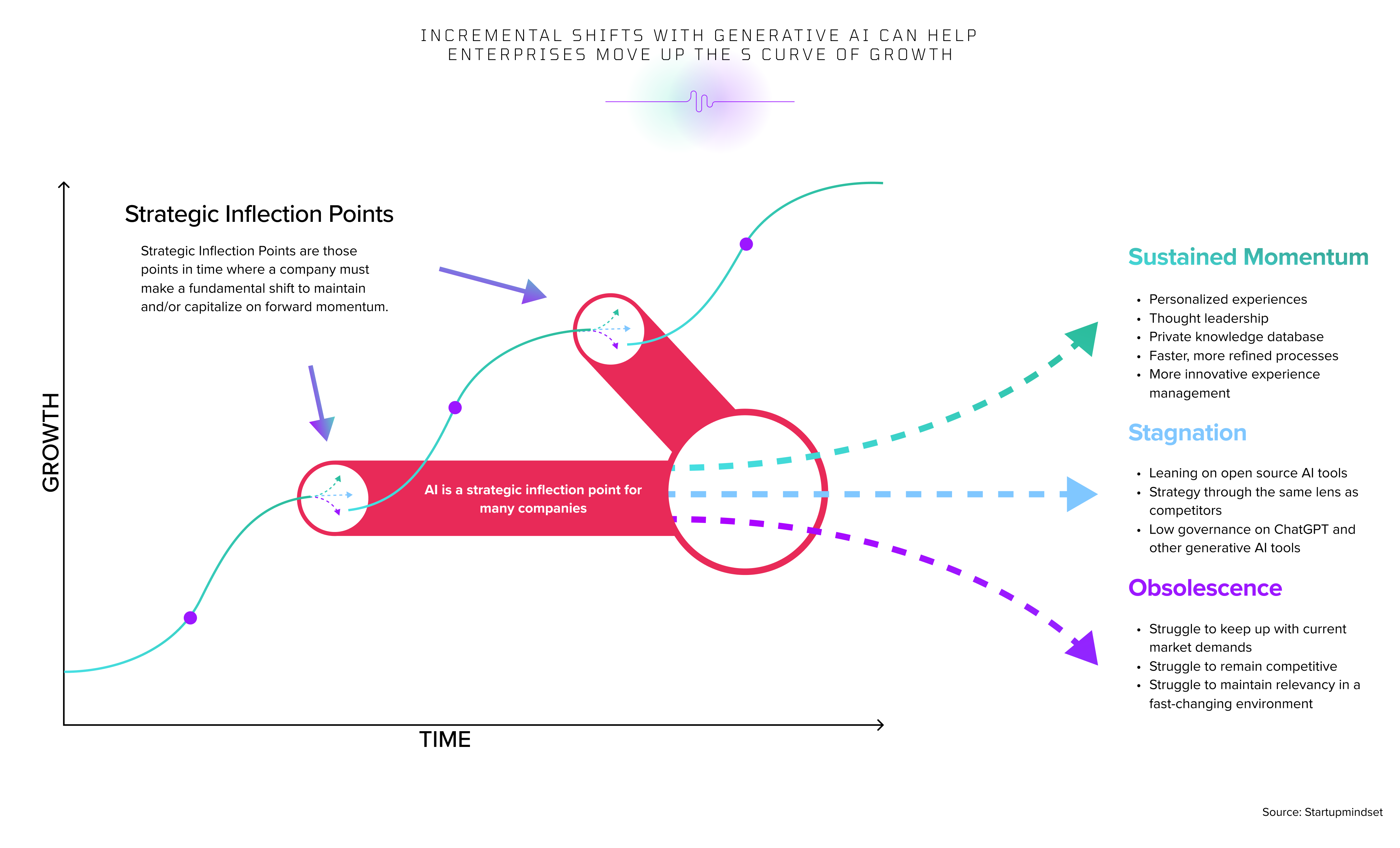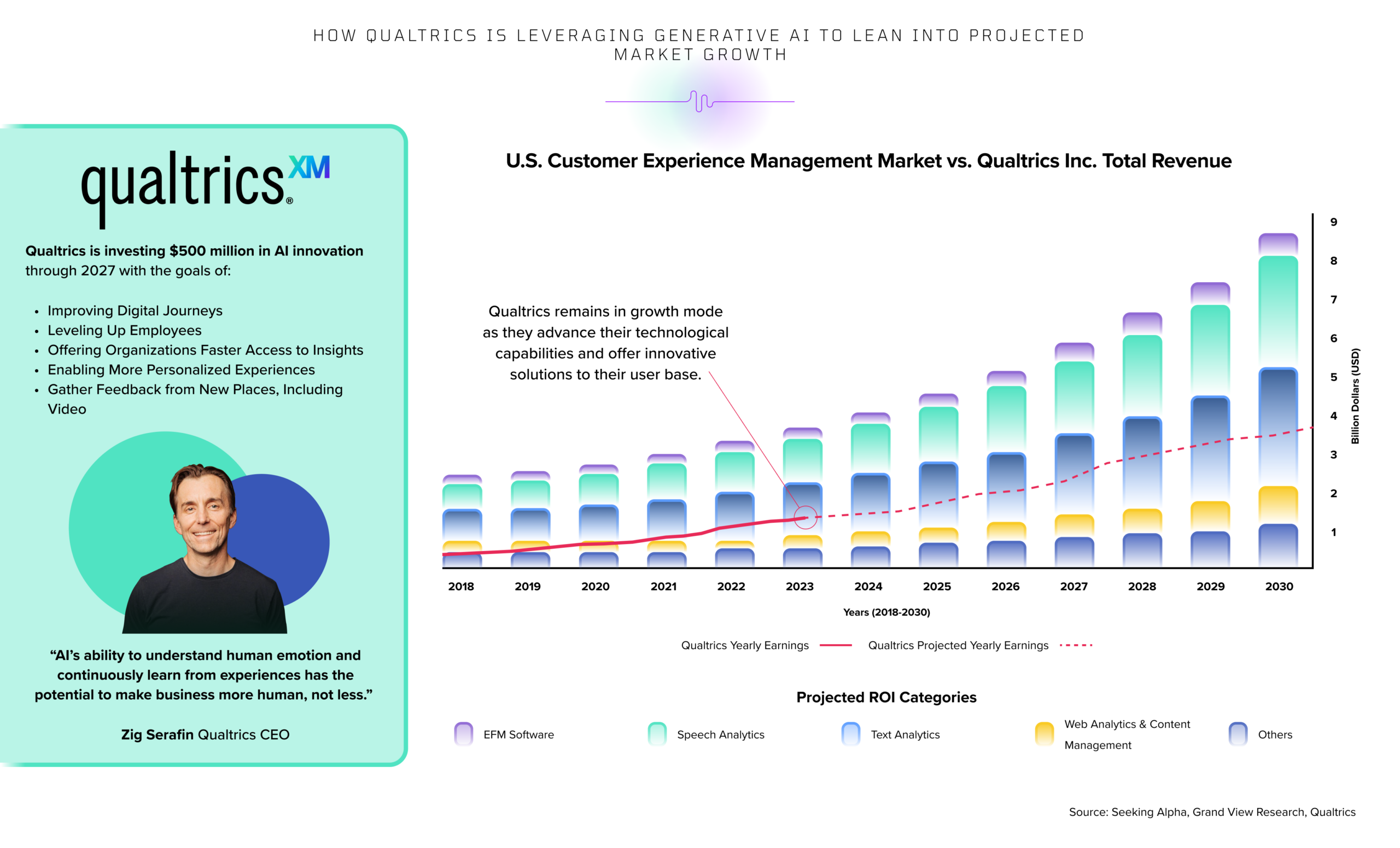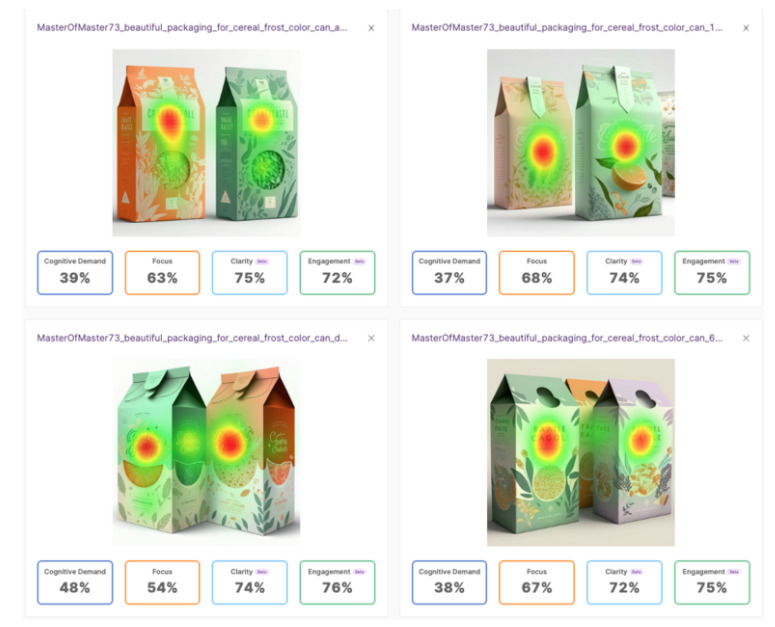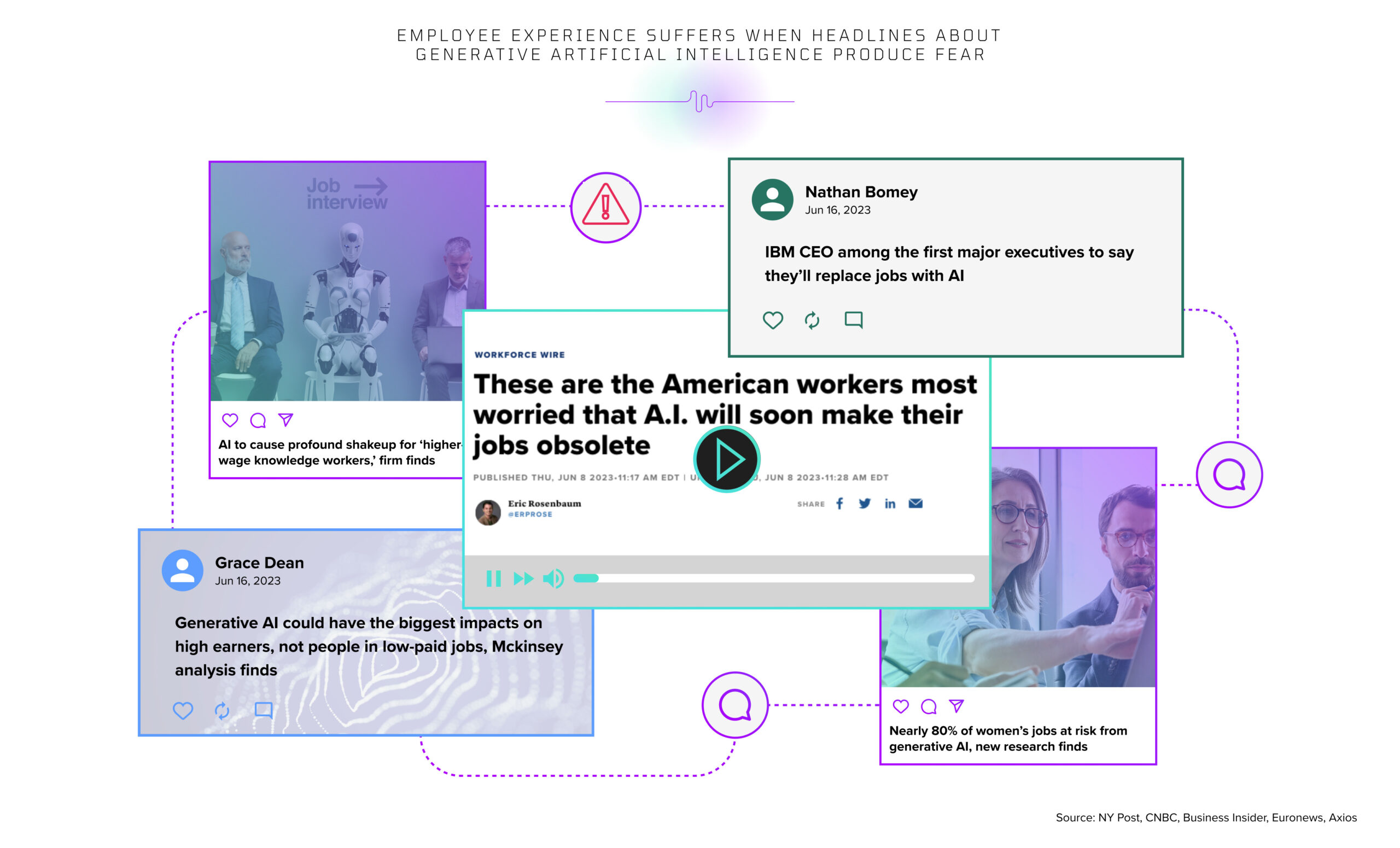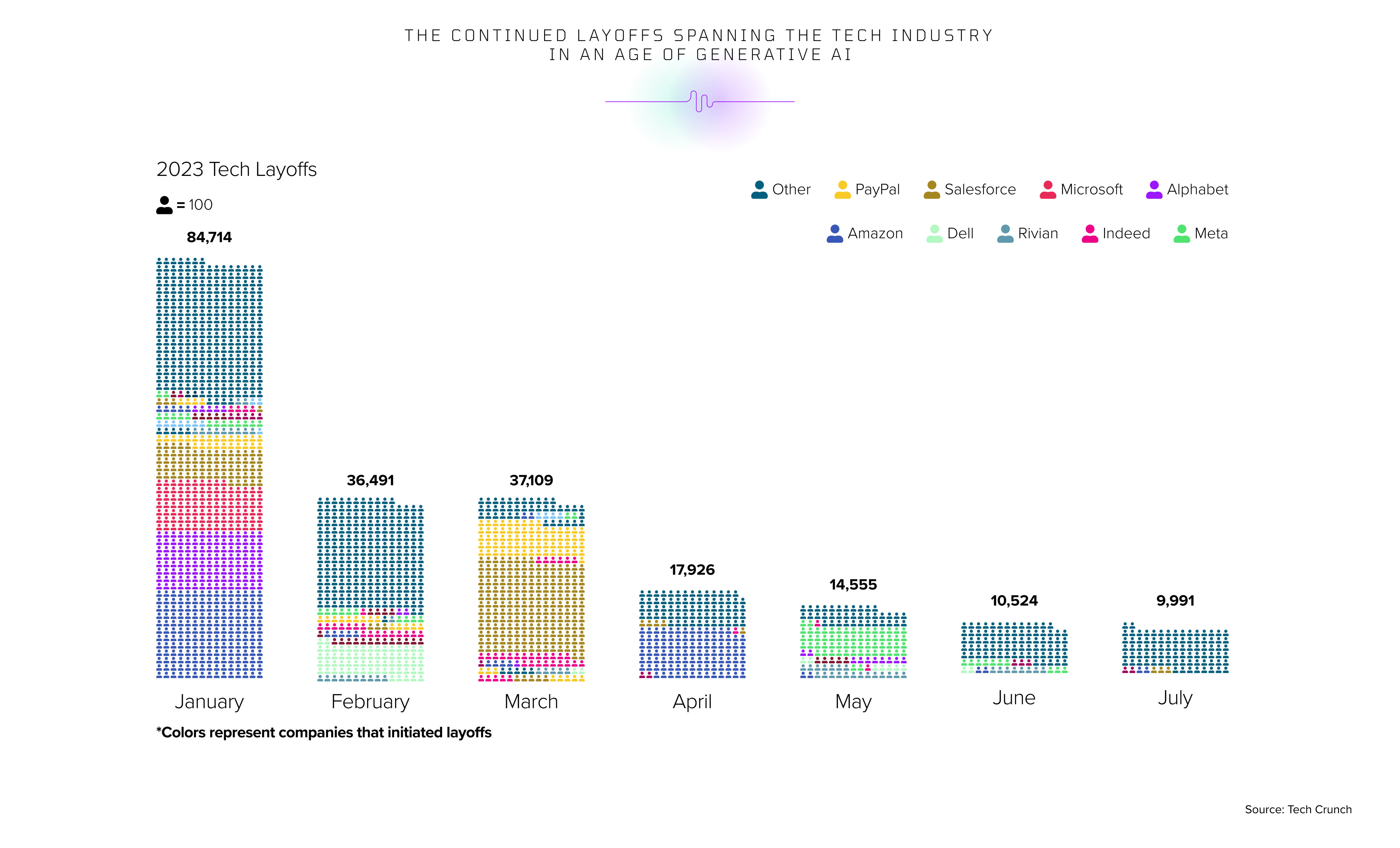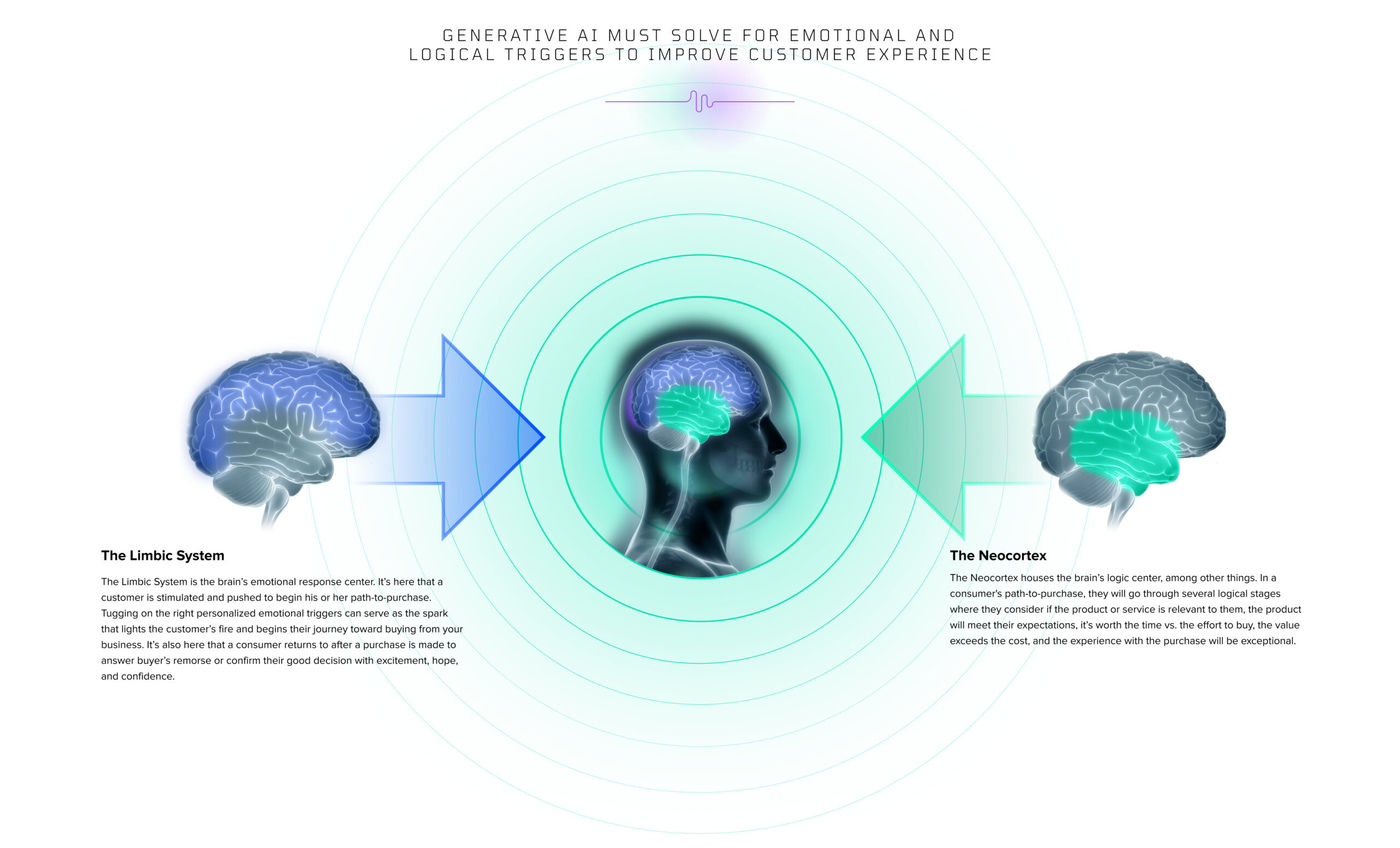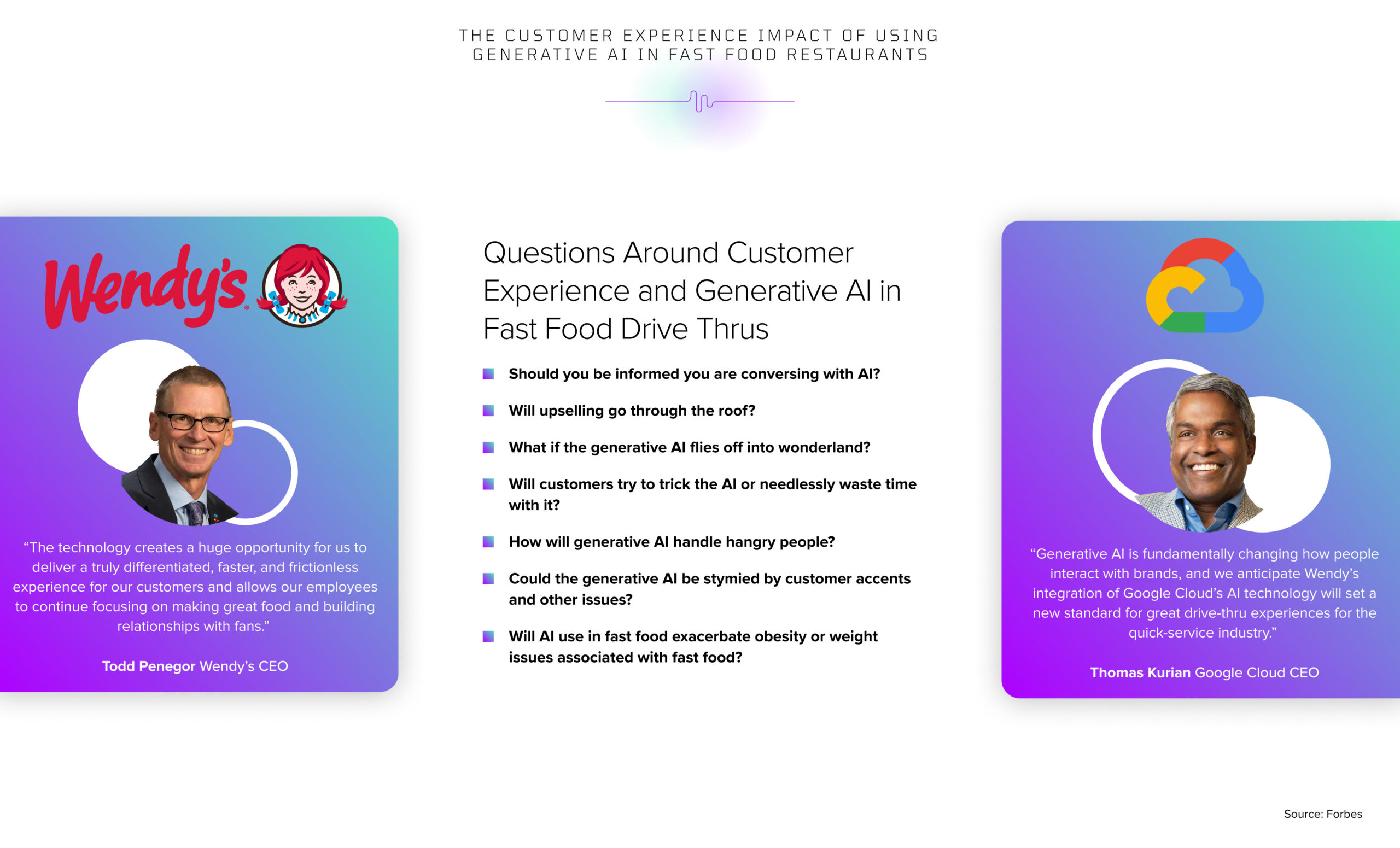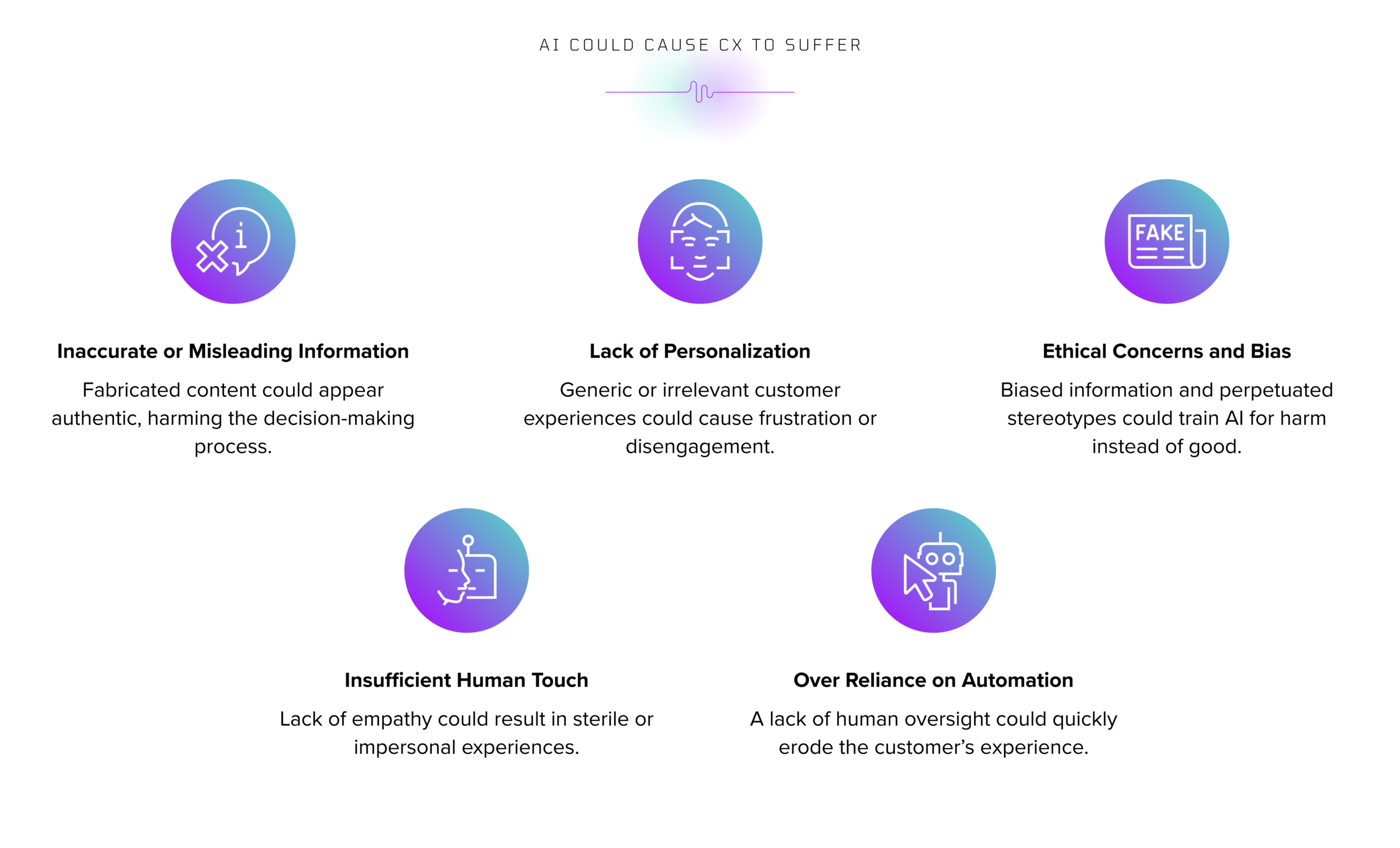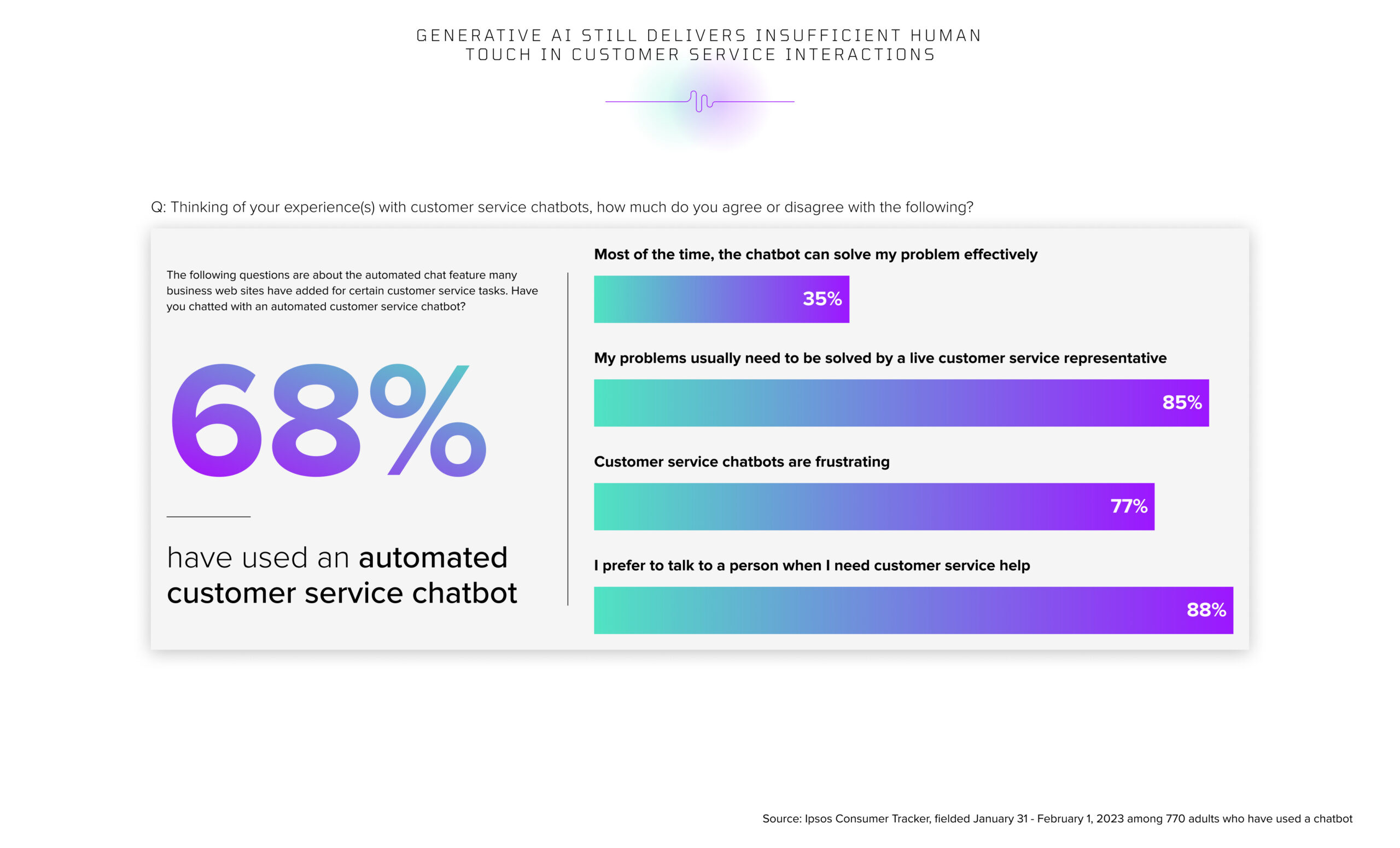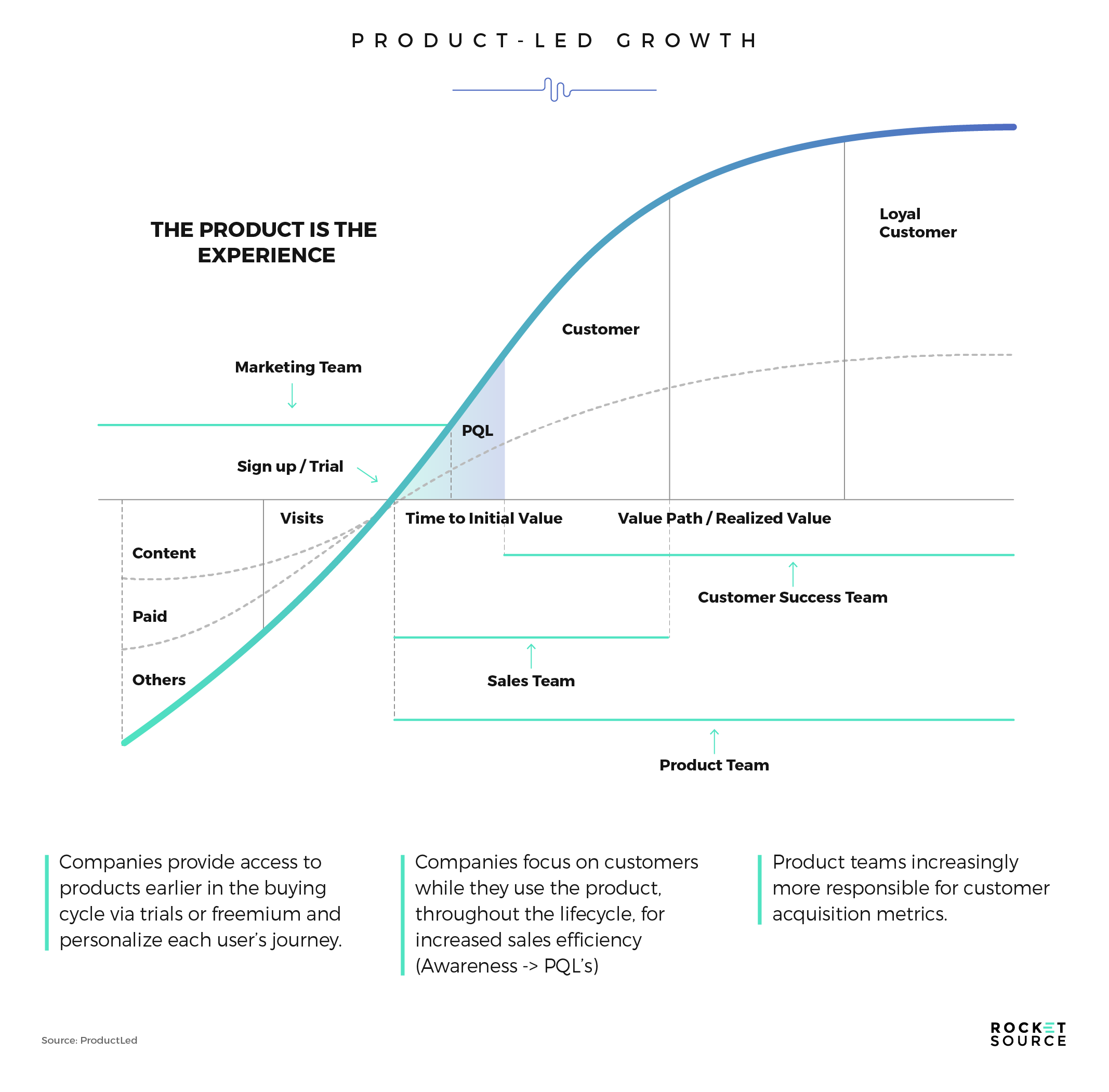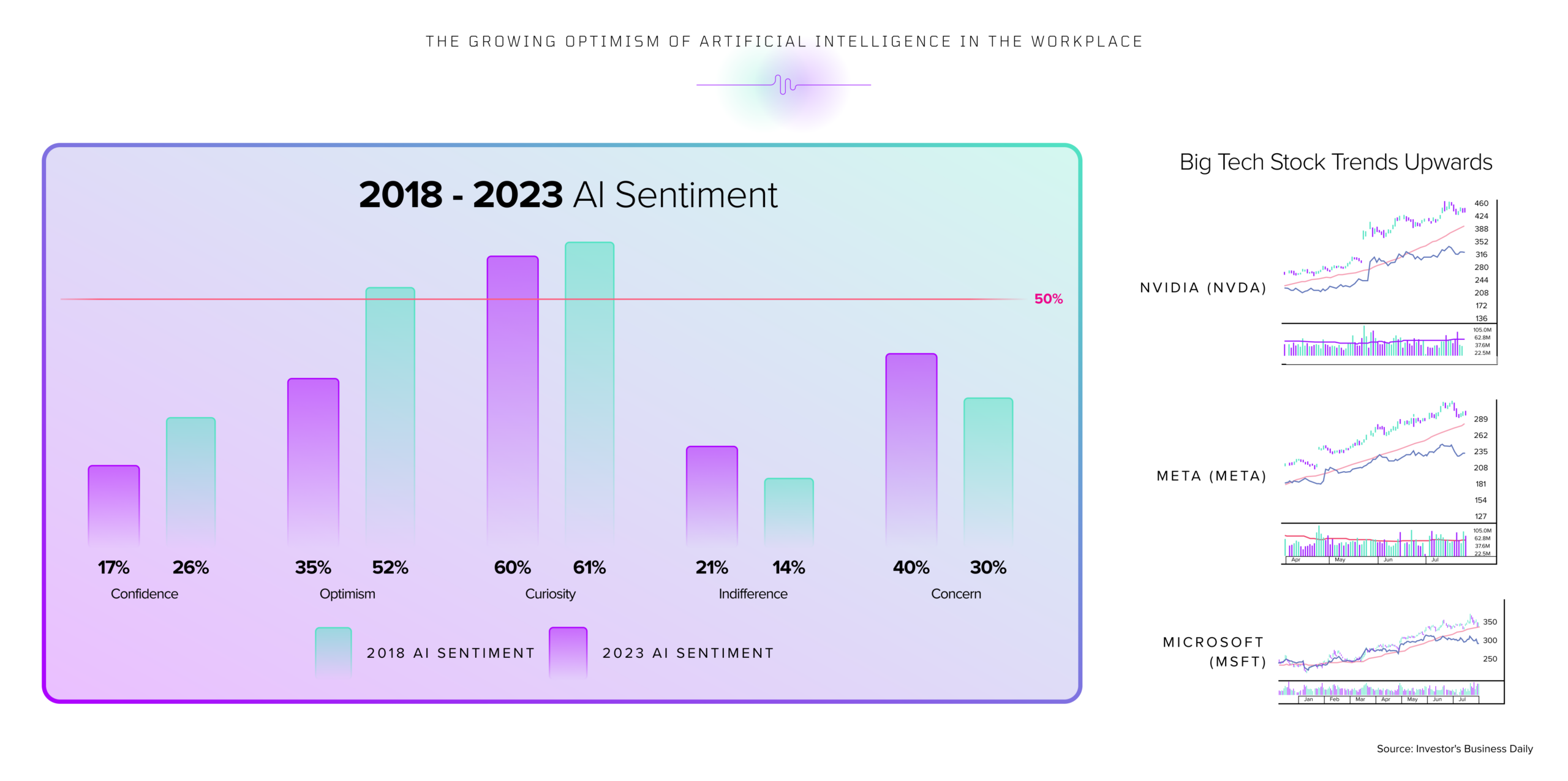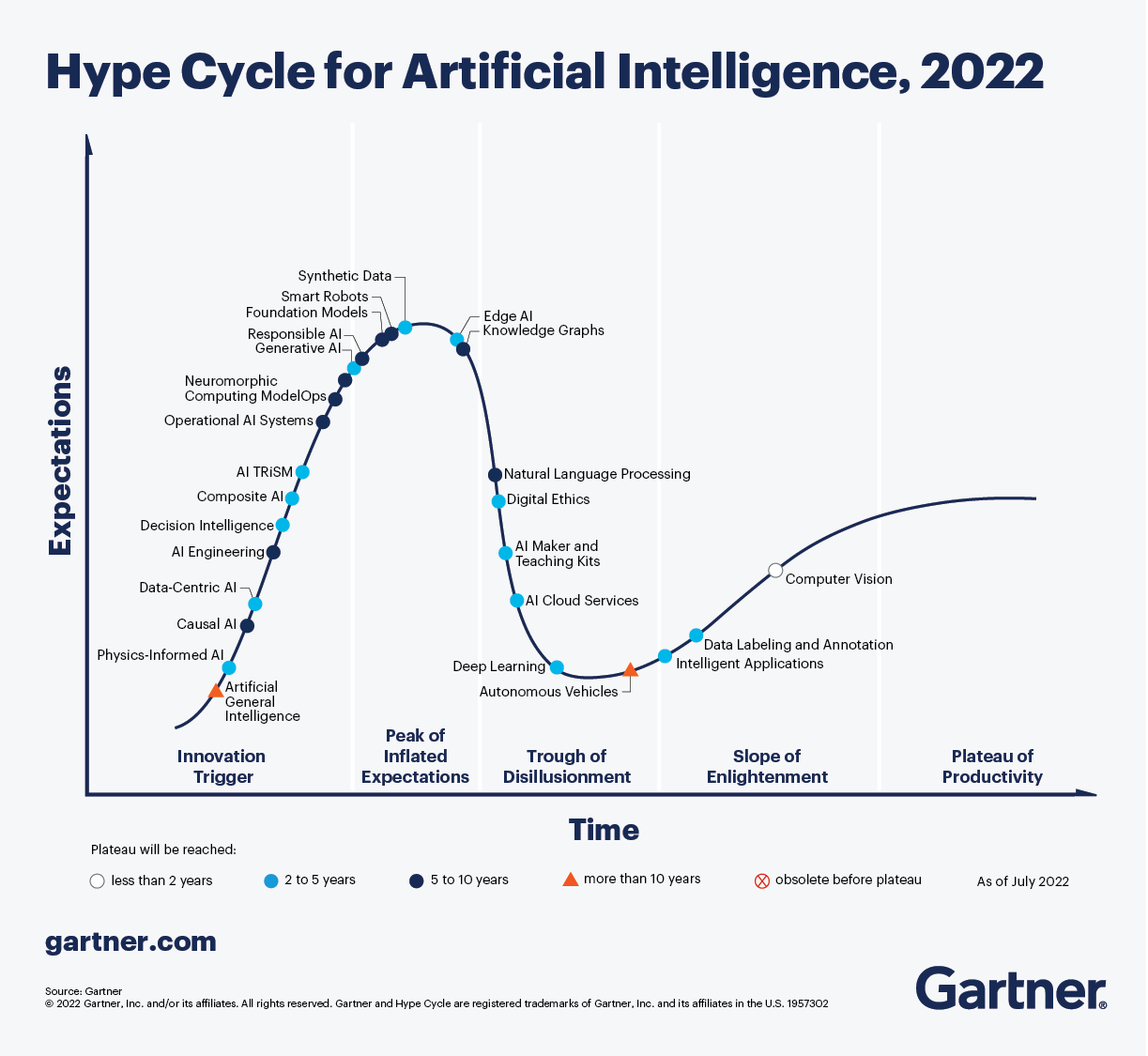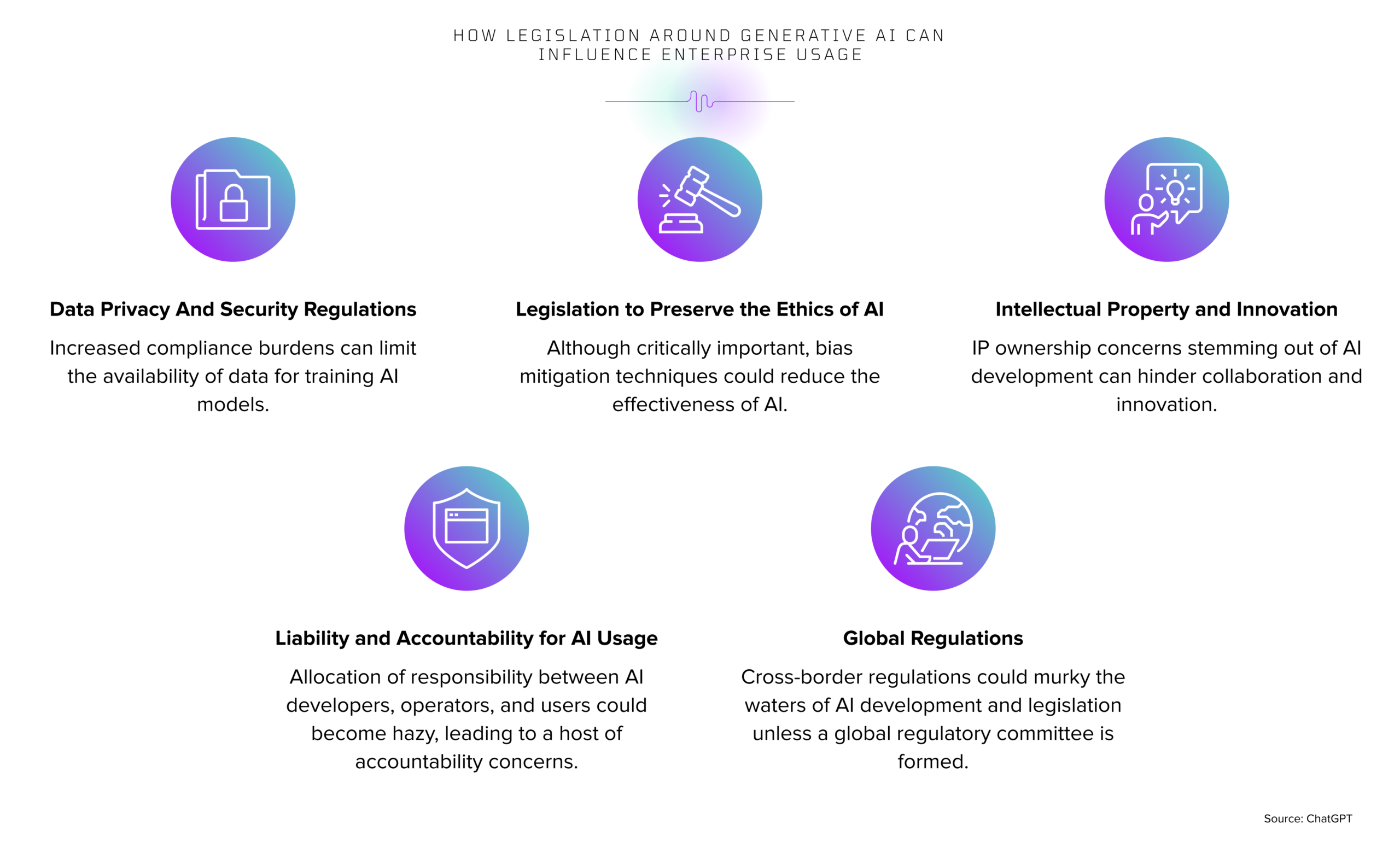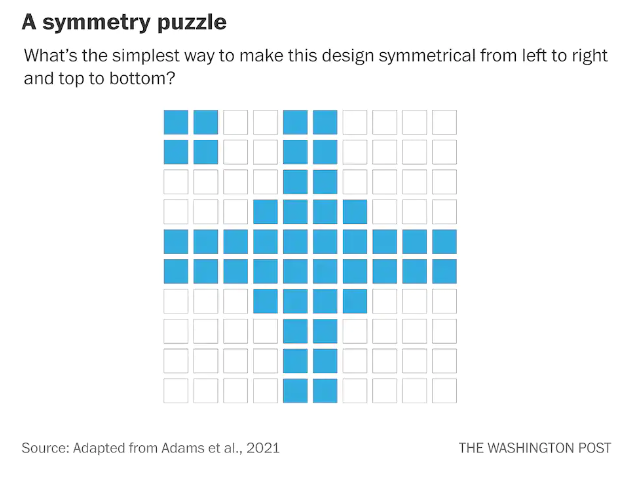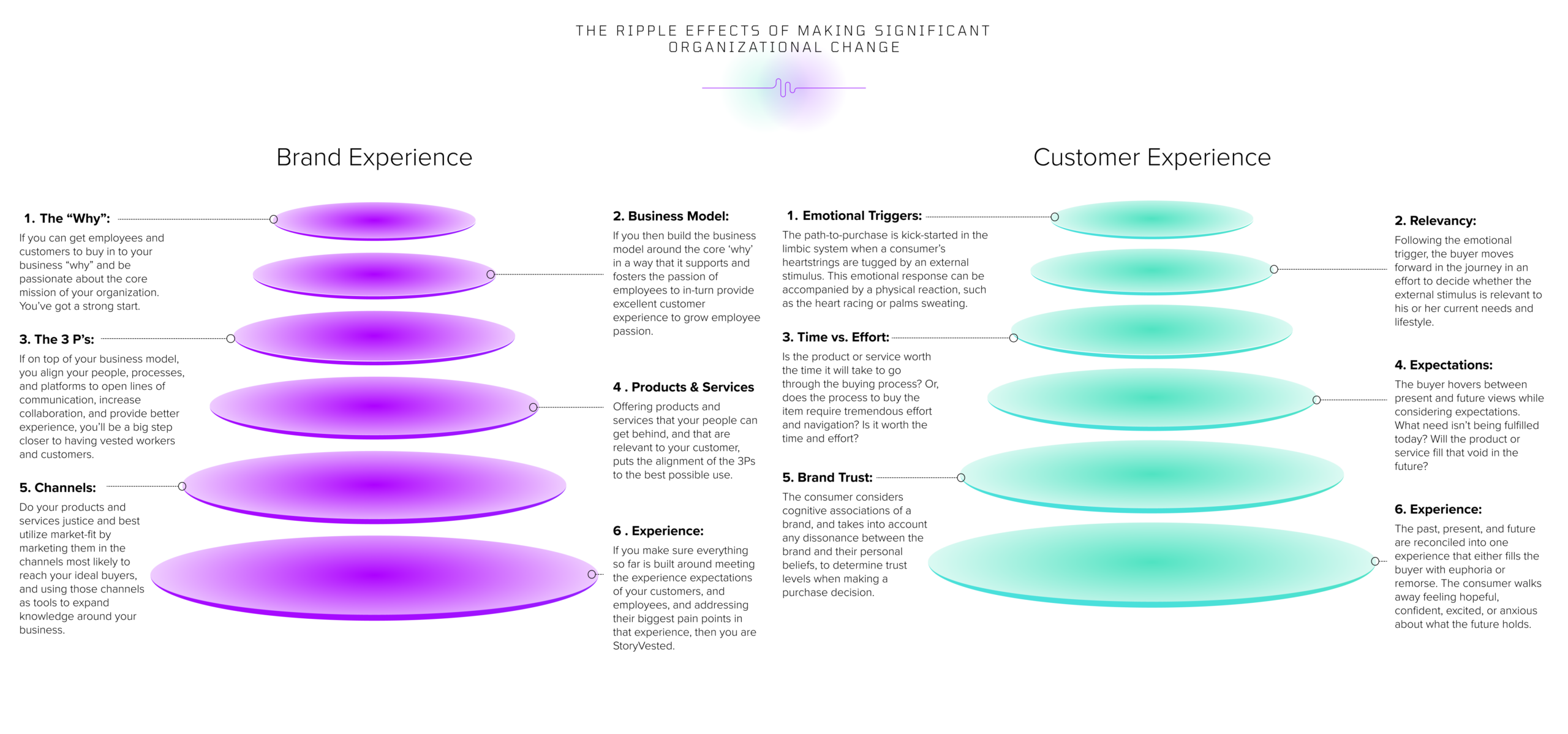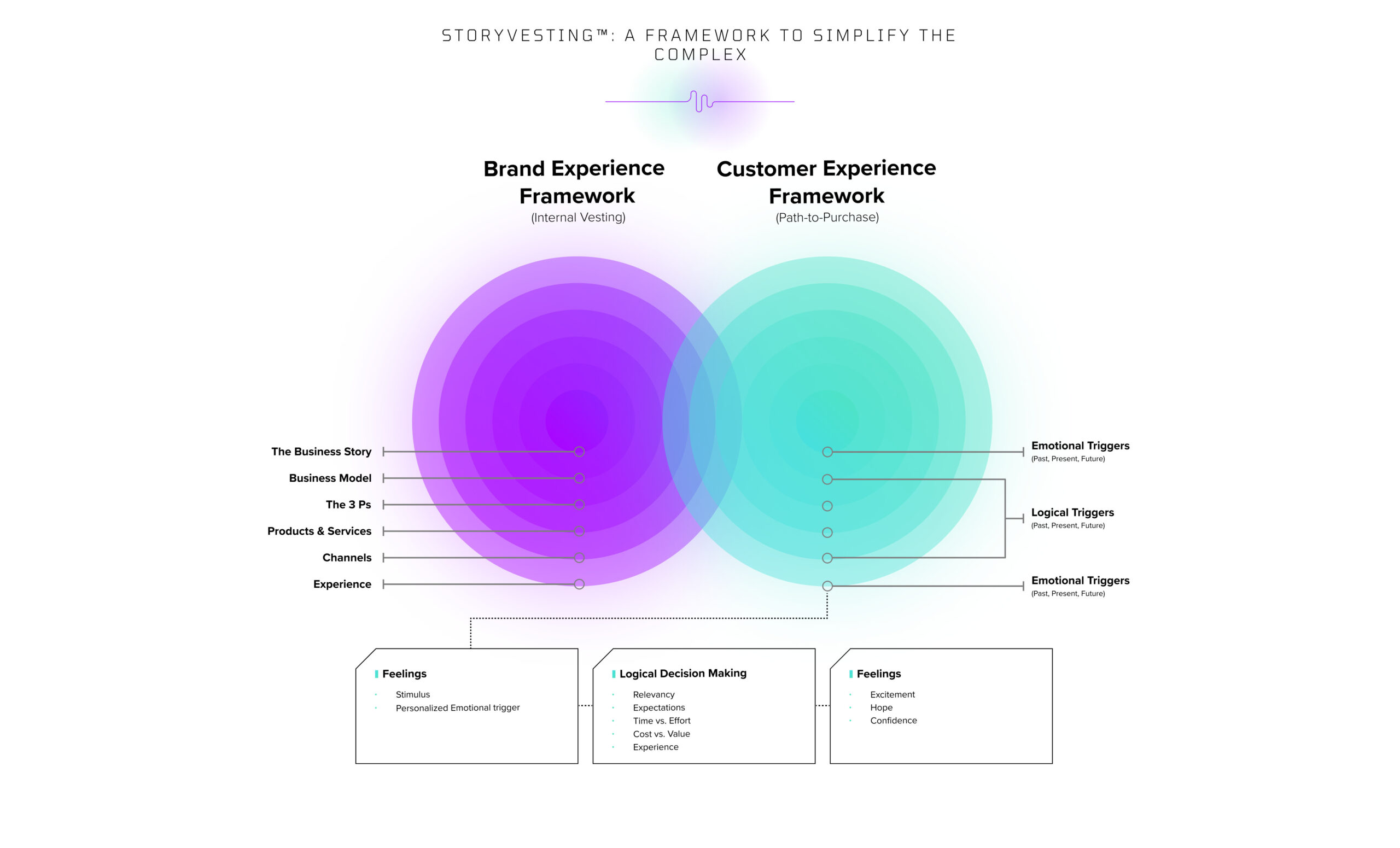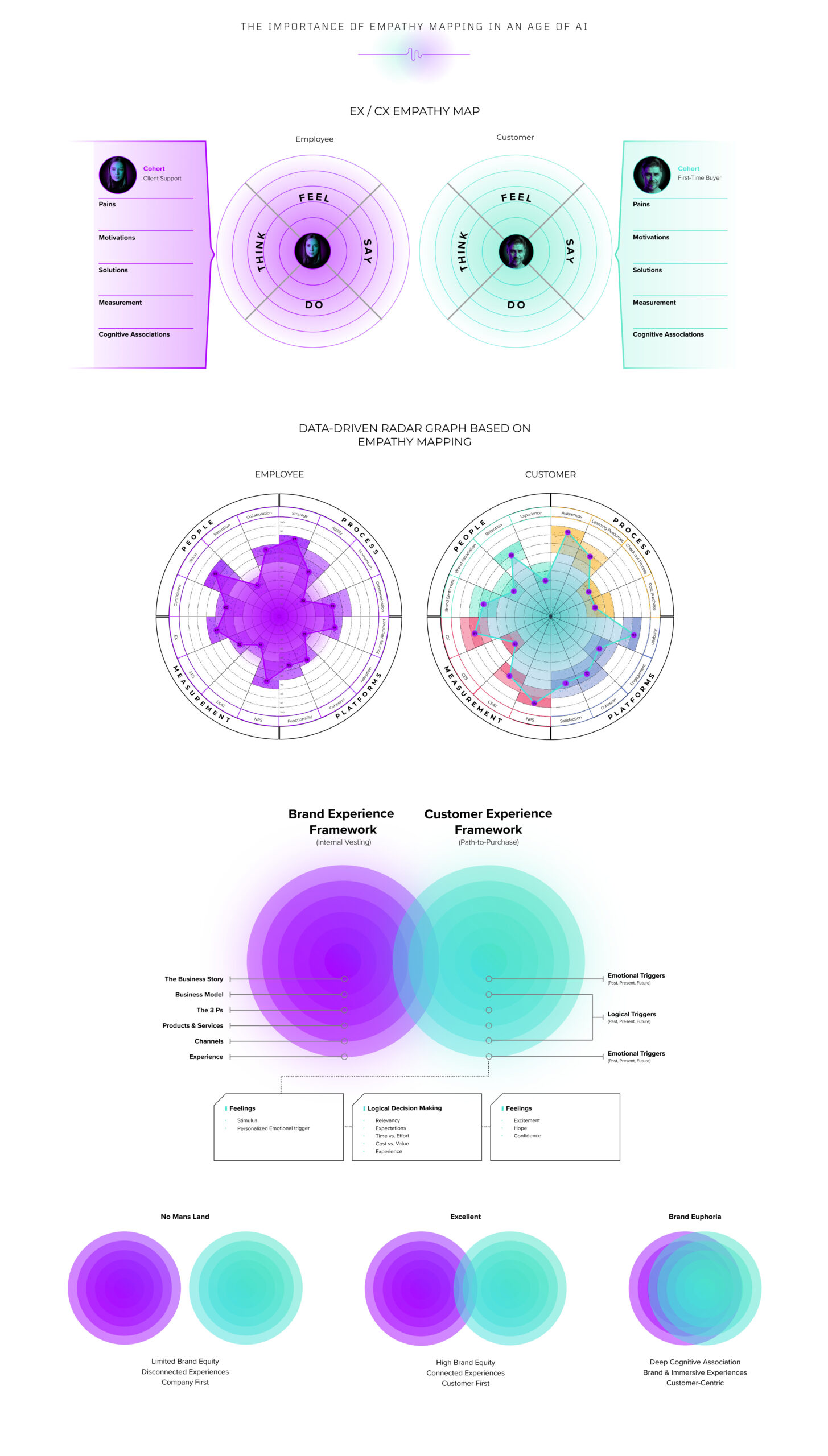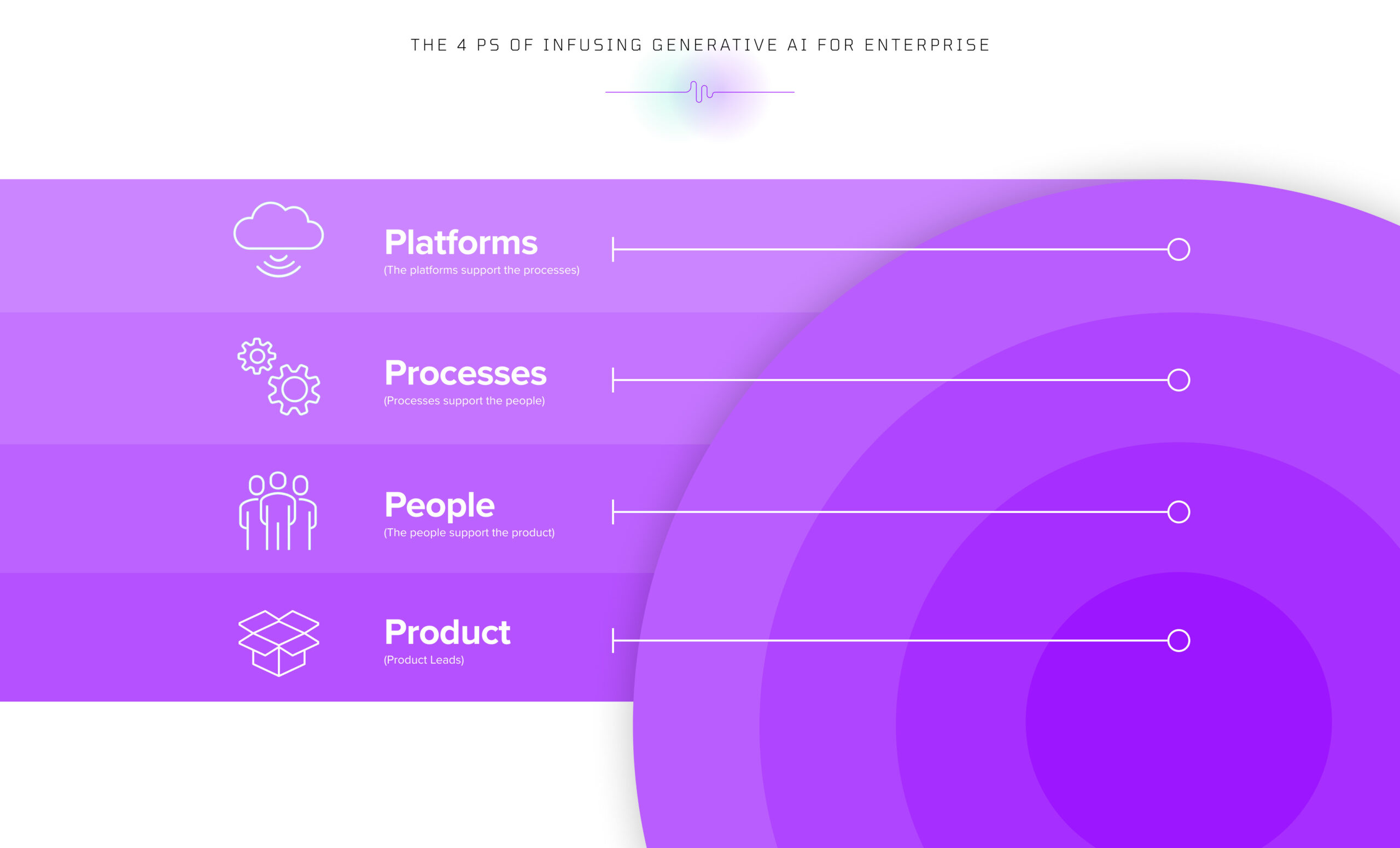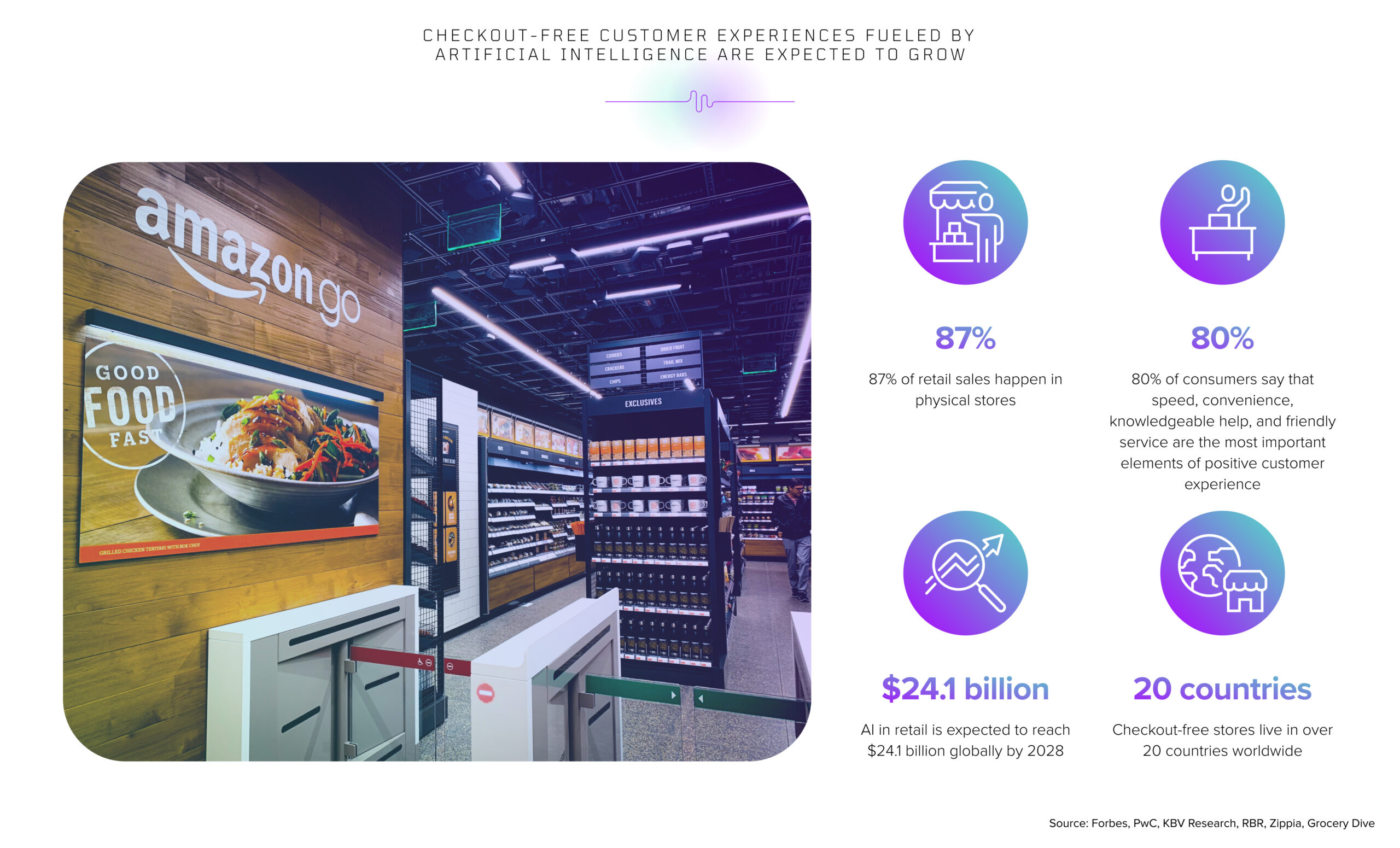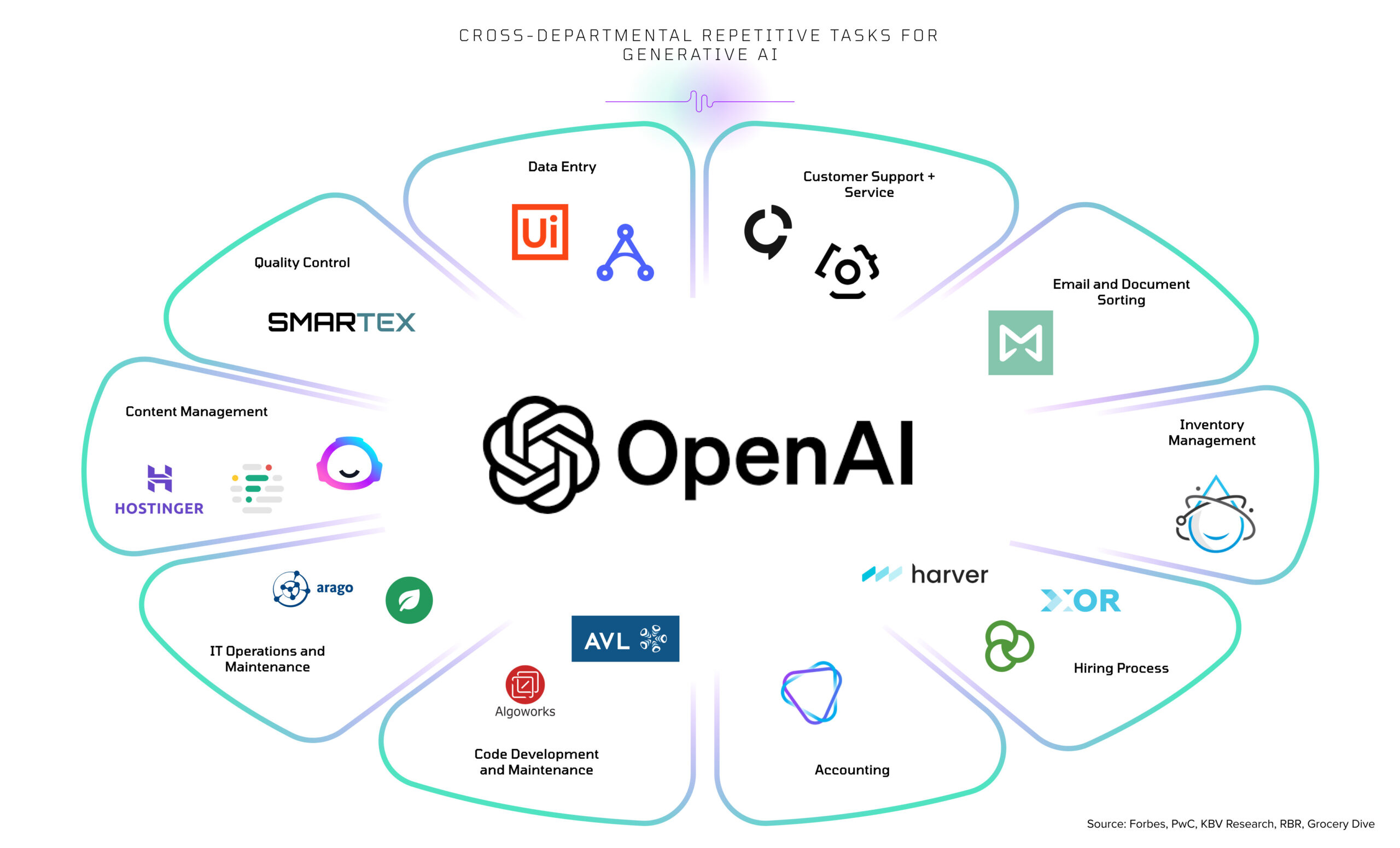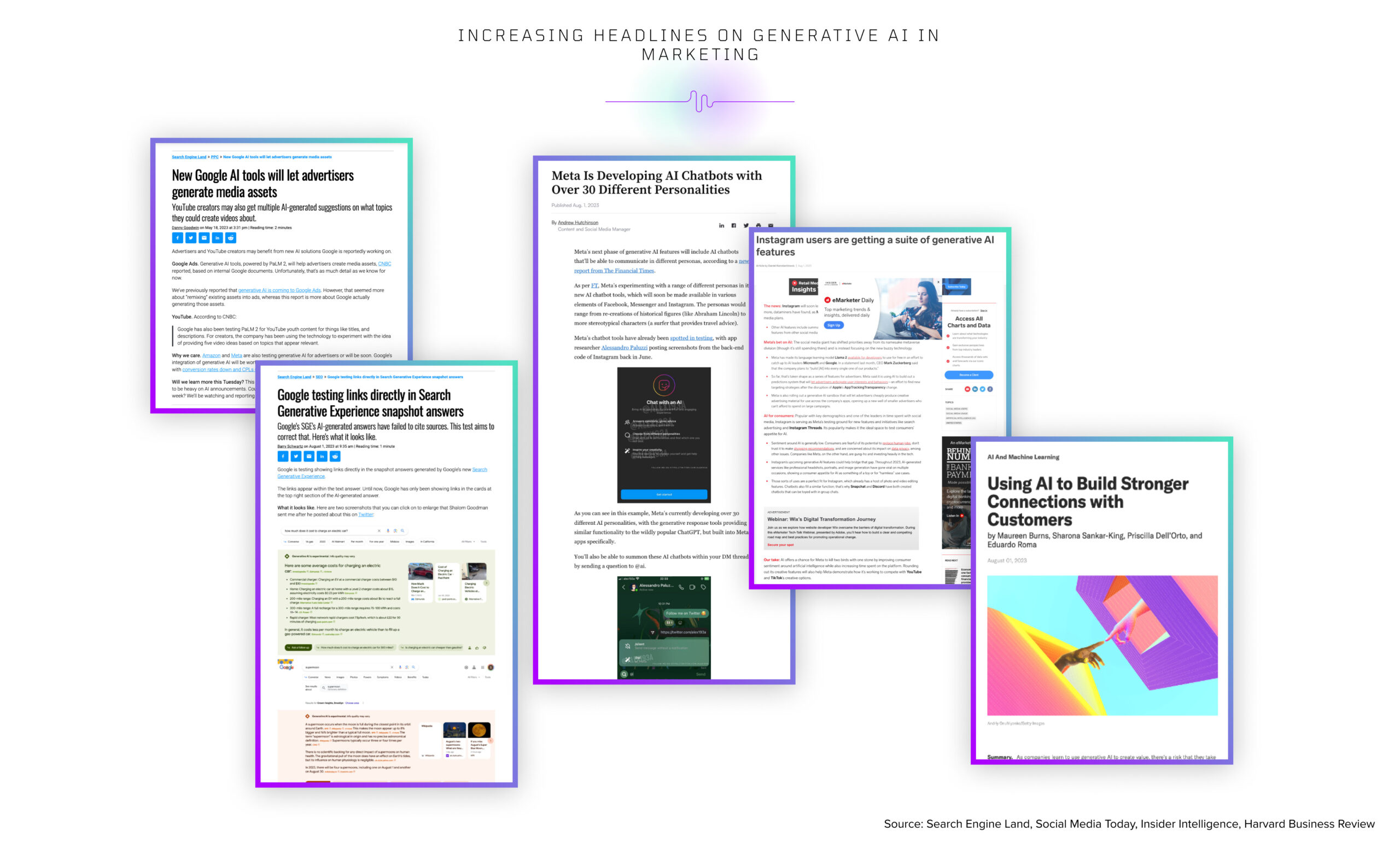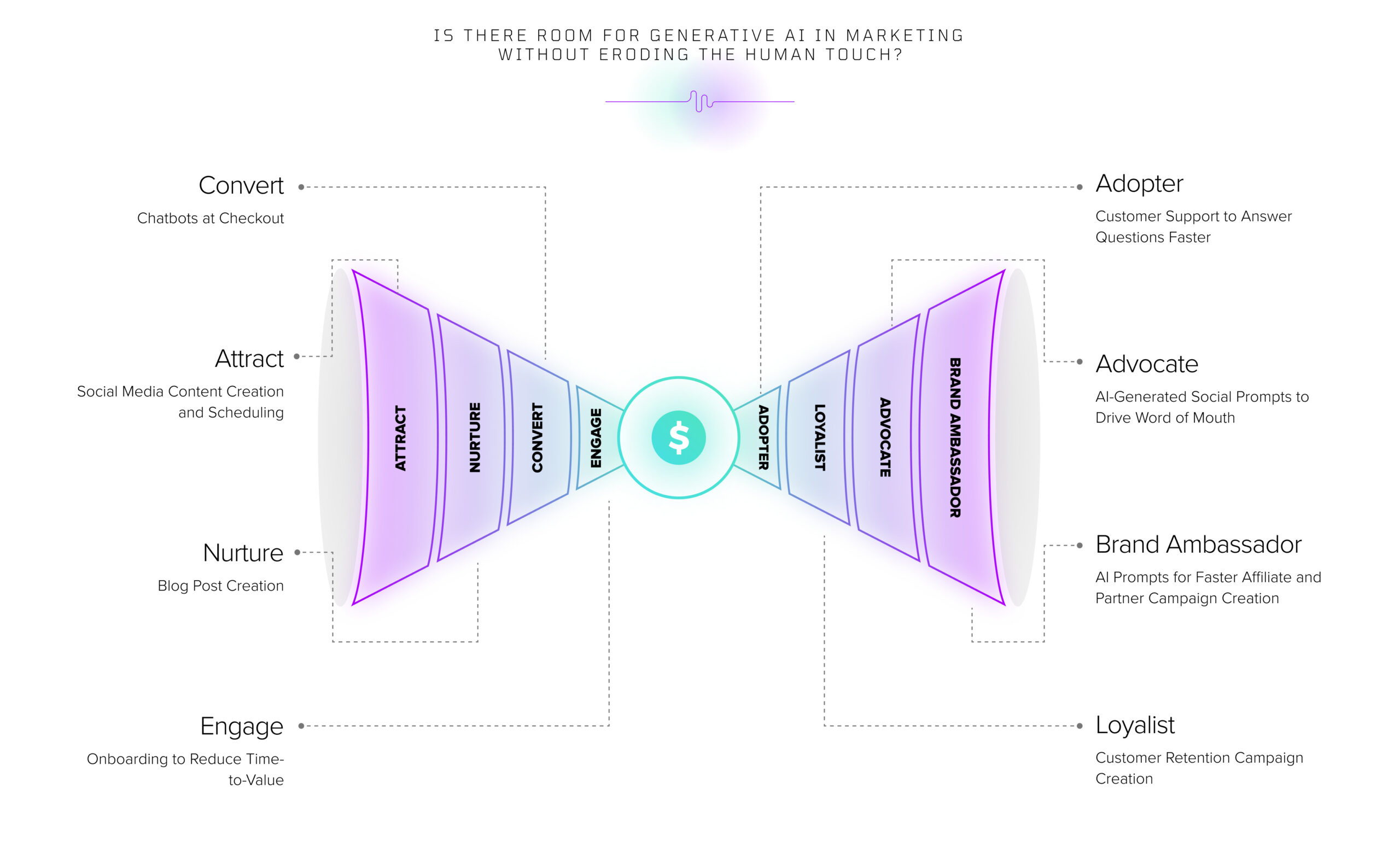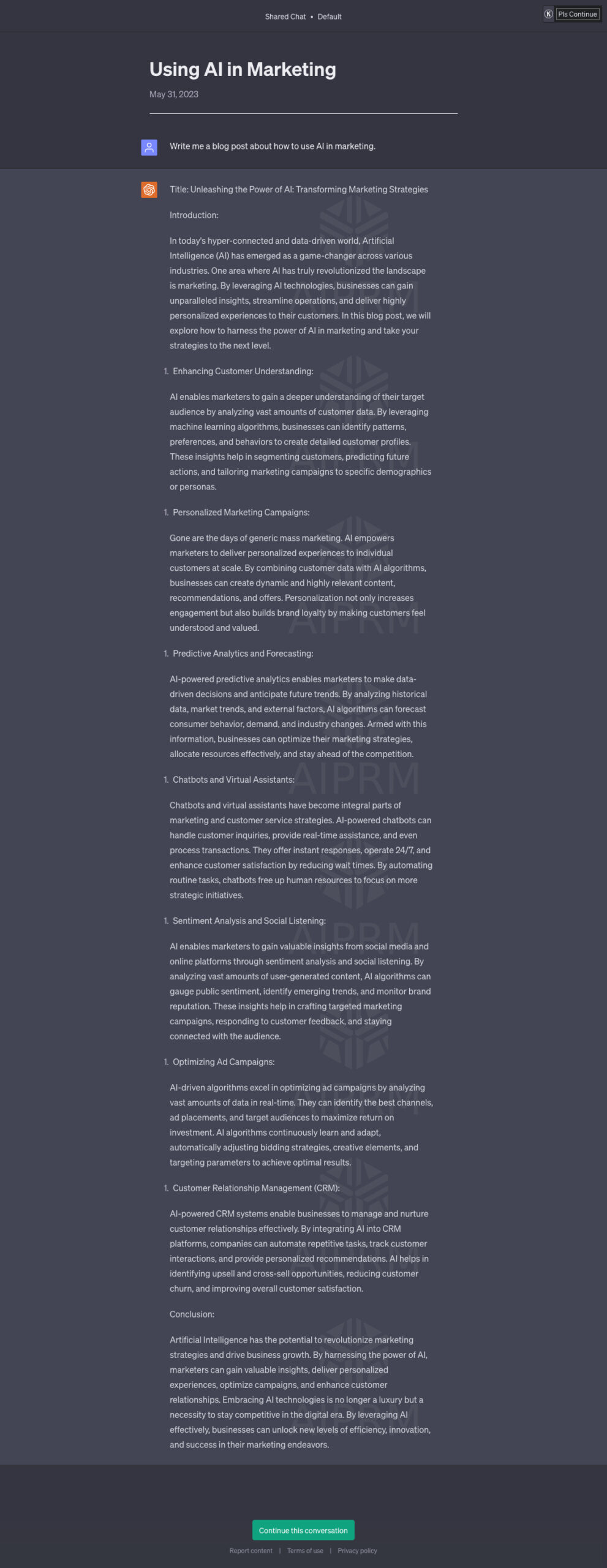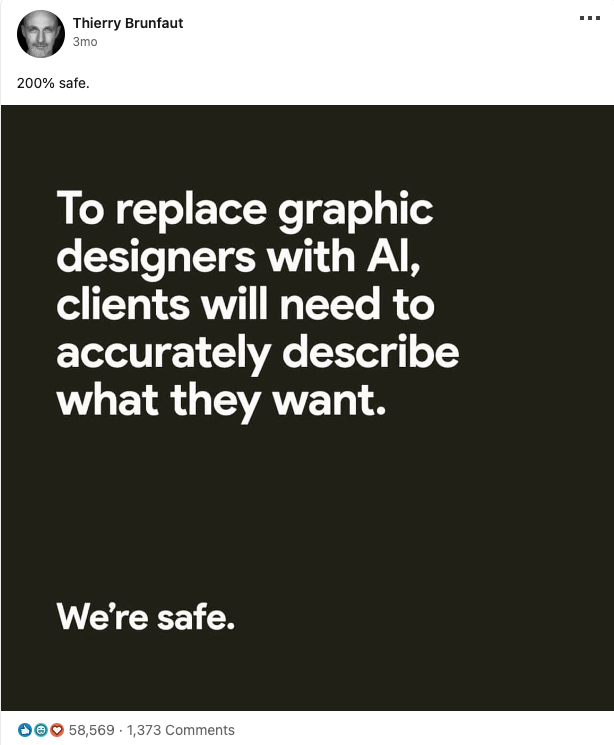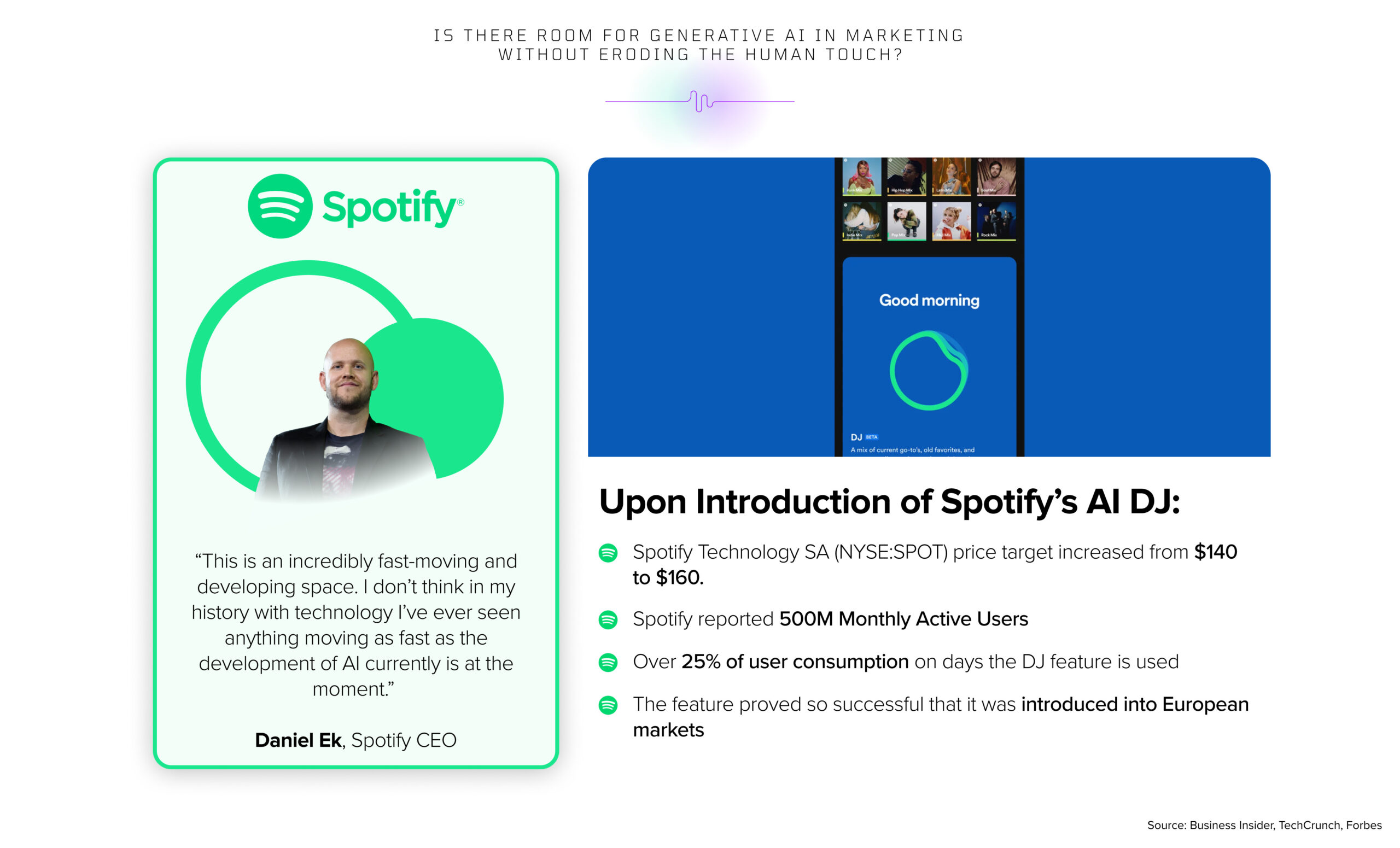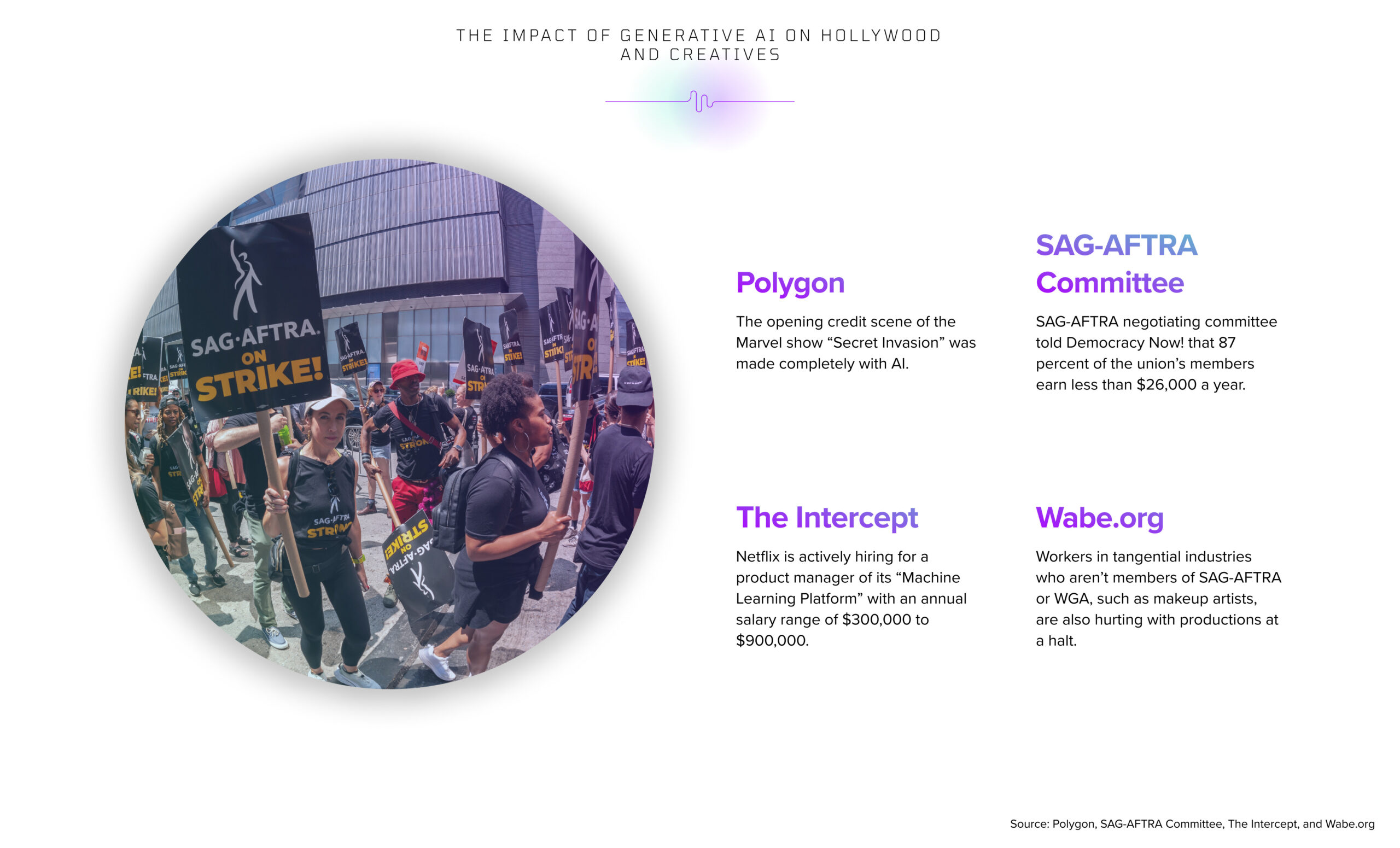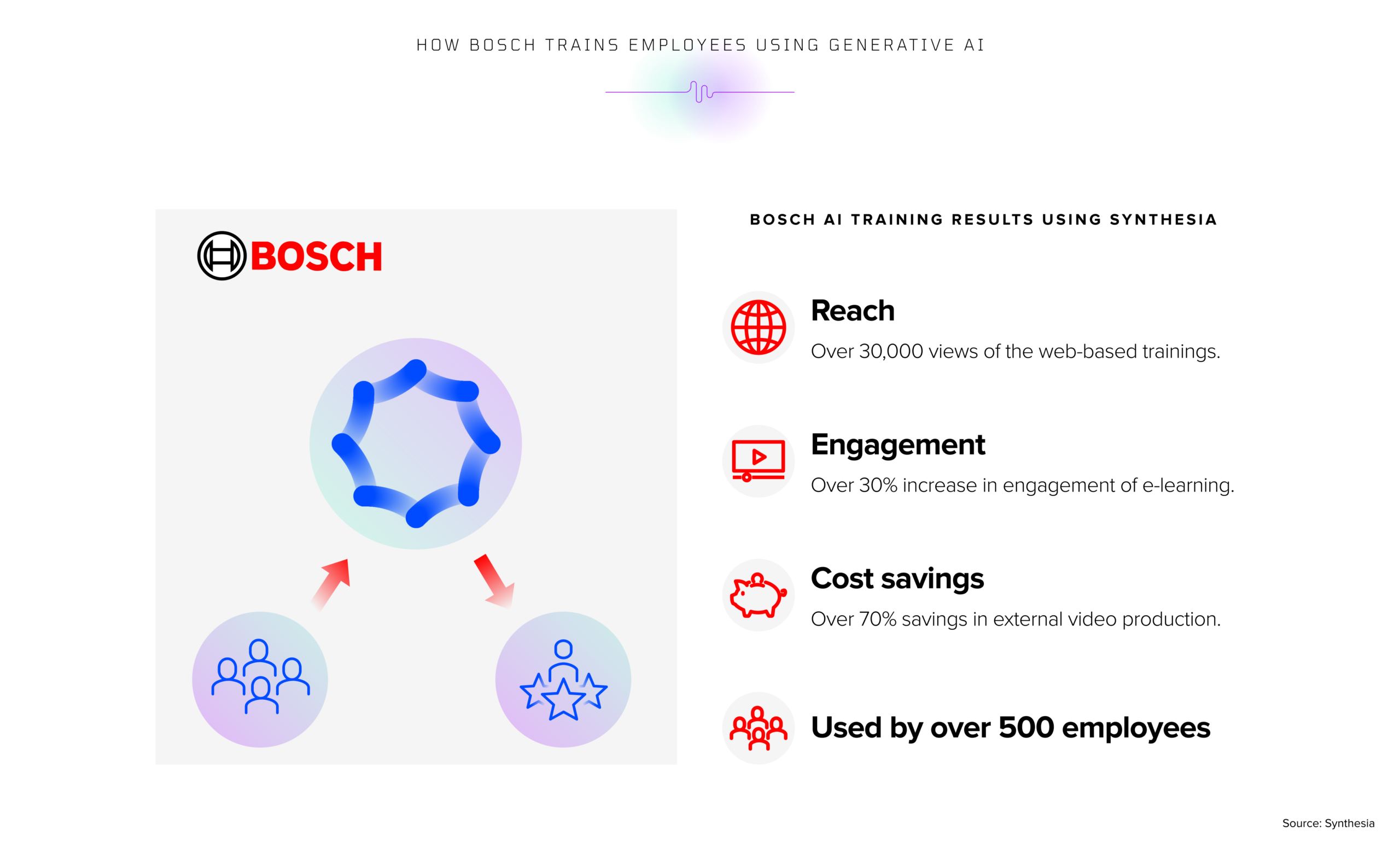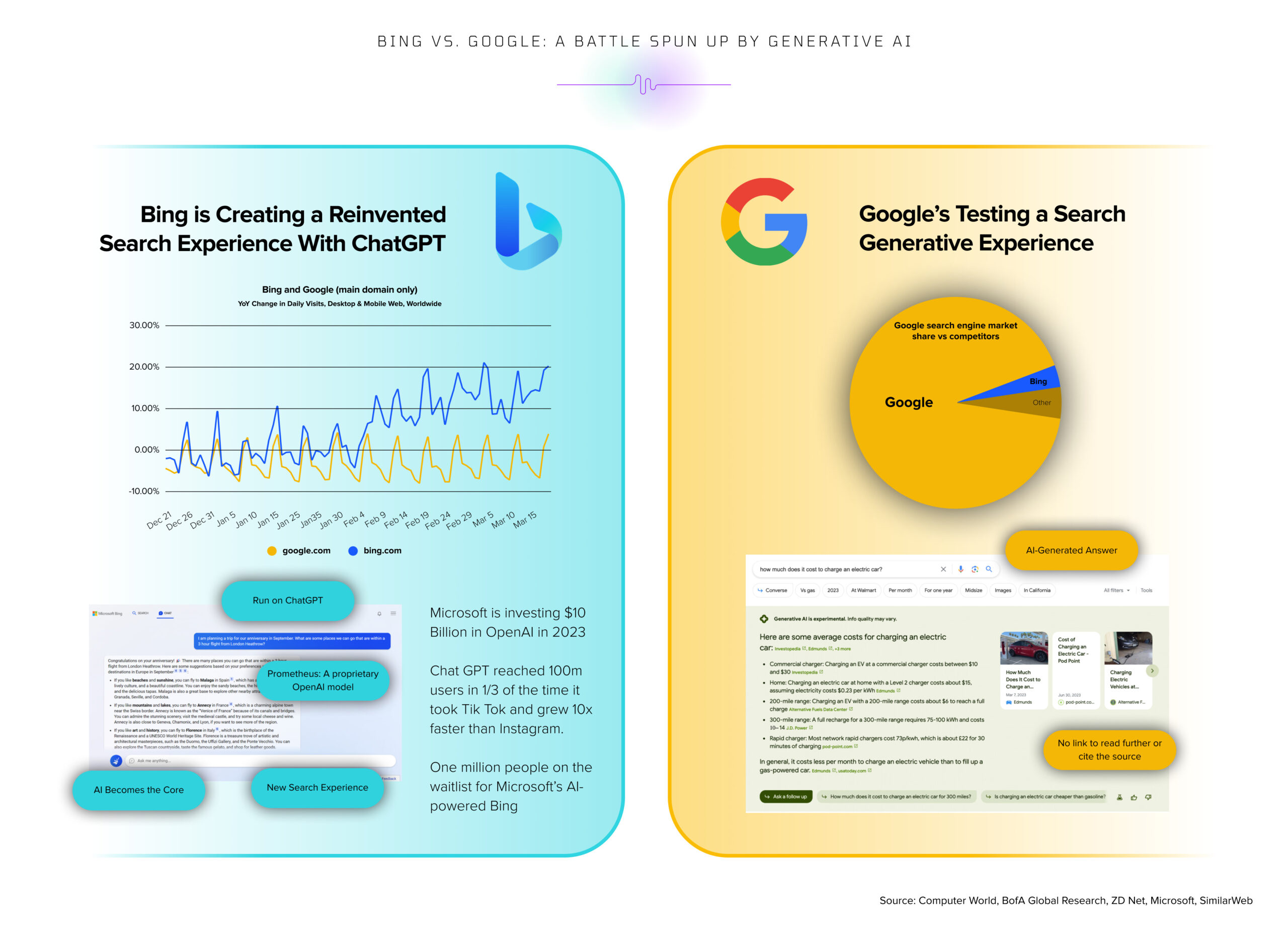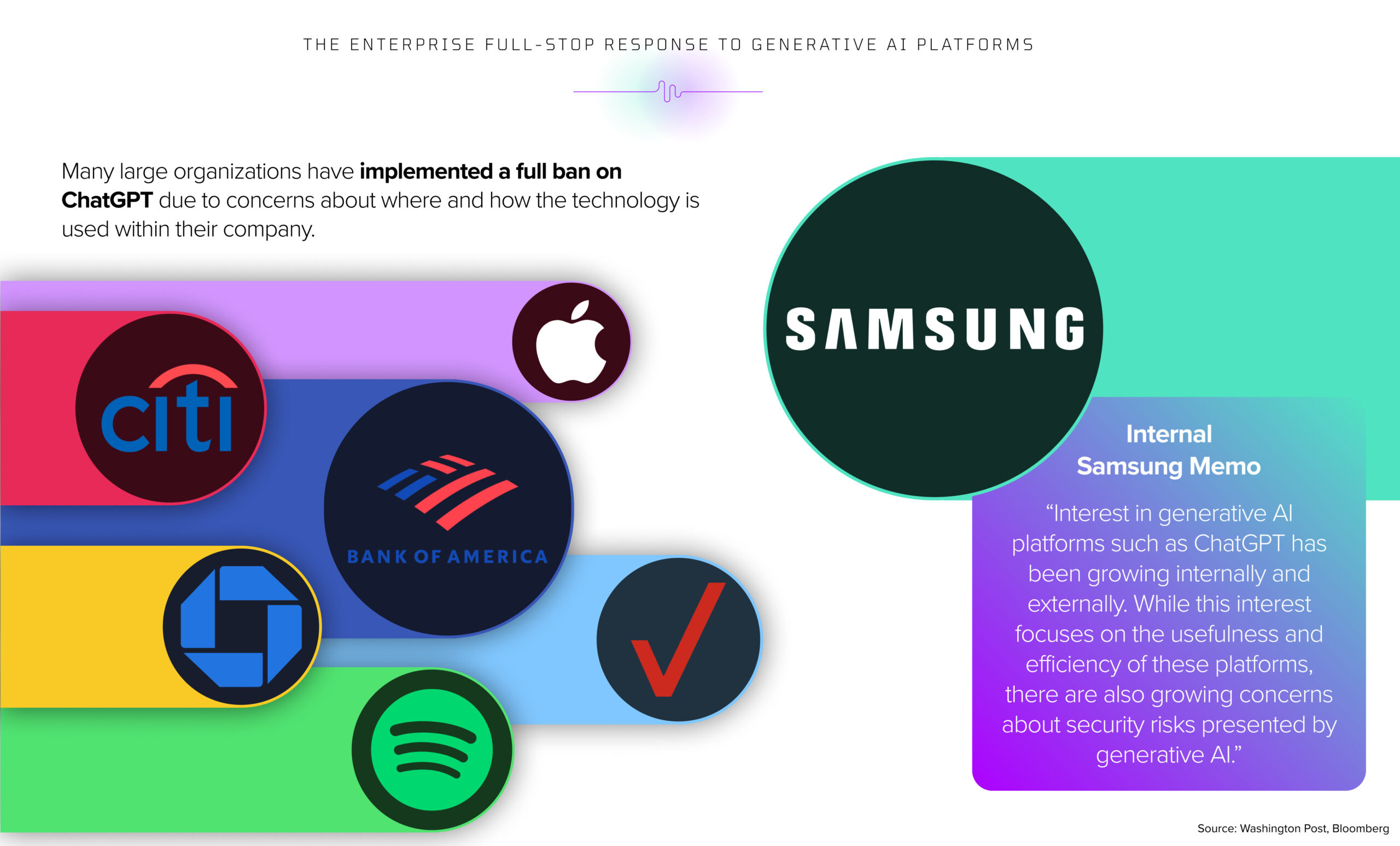A Framework for Navigating Generative Artificial Intelligence for Enterprise
Crack open your inbox or News app on your phone, and you’ll likely see headlines promising insight about generative AI this and artificial intelligence that. When you do, what’s your response? Some people we talk to lean back, preparing themselves for similar fear-mongering found on social media today. Others get visibly uncomfortable, squirming a little in their chairs. Yet others again will lean in, ready for a philosophical debate around what AI means for the future of humanity.
No matter which reaction you’re having right now reading the title and clicking into this post, one thing holds — generative AI is an important topic to discuss when it comes to staying relevant as an enterprise today. Still, we understand the deep-rooted emotions that coincide with the term AI today, and in this post, we’re working hard to help quell those fears. Here’s why:
If you get paralyzed by fear, you can’t capitalize on the opportunity.
We know emotions are running hot and off the charts when topics like ChatGPT, Dalle, Midjourney, AI, generative AI, machine learning, you name it, are brought into our places of employment. There’s a tremendous vulnerability in today’s corporate world around job loss, shifting market expectations, and navigating new technologies inside and outside the organization. That’s why we’re writing this post. Our goal isn’t to add to the noise, get philosophical about how bots will take over the world, or talk about the political climate surrounding AI. There’s plenty of chatter about the future alongside artificial intelligence. If you want to dive into any of those areas, we can point you to plenty of podcasts.
Instead, in this post, we will address something few are discussing — how to leverage a framework and build an organizational roadmap that keeps your team, company, and brand relevant alongside AI. Let’s get into it.
The Hesitation Around Adopting Generative Artificial Intelligence for Enterprise is Real
Perhaps one reason there’s so much hesitation around generative AI is that few organizations know how to manage it effectively. Where does it fit in? Will it replace jobs? Whose job? How will it impact the current processes? Why rock the boat if everything is currently smooth sailing?
These, and loads of other questions, are fueled by a chasm between where enterprise currently stands and where many employees see it going. Specifically, the employee skills gap and trust are seen as the biggest impediment to business adoption of generative AI, according to ZD Net.
63% of service professionals believe generative AI would help them serve their customers better, and 84% of salespeople using generative AI say it has helped them increase sales. However, only 41% of employees currently use or plan to use generative AI. What gives? Although teams know that AI has the potential to elevate their skillset and increase productivity, many worry that the potential could lead to job loss. In addition, security measures and oversight have eroded trust in the technology, causing a lot of understandable hesitation among decision-makers at the enterprise level.Despite these hesitations, an undeniable influx of innovations is happening in the enterprise world with generative AI. Now, tools like ChatGPT are quickly evolving beyond being leveraged as a digital assistant and now have real implications for how efficiently and effectively enterprise organizations drive growth with AI, and without the many risks that go along with this type of transformative technology. It’s a dual-edge concern for most companies. While there’s a struggle to reach top-line goals, companies are equally challenged to protect the bottom line. Generative AI can impact both sides of the financial sword.
Every day we have conversations with the C-Suite, directors, and managers about how to solve complex problems. AI happens to be one of those complex problems facing today’s world. This post aims to help you adapt and change in a market where AI is becoming impossible to ignore. Instead of shying away from generative AI entirely, what if we shifted the conversation to innovate what’s possible with this new technology, and how to embrace those opportunities to keep your organization moving up the S Curve of Growth?
Embracing Generative Artificial Intelligence for Enterprise
The term “artificial intelligence” is a broad term many like to discuss, but few understand. That lack of understanding is fair but requires some groundwork when wrapping your head around how to use it in the enterprise environment and where to avoid using AI altogether. But here’s the reality — artificial intelligence itself isn’t new. Looking at how long it’s existed and how this technology has evolved over the years can help tame the monster a bit as you consider where and how to adopt AI in your organization.
In this graphic about how artificial intelligence works by Neil Sahota, you can see that AI dates back to the 1940s when neural networks hit the scene, connecting various pathways of data into one place to form a conclusion. Over the following decades, developers and creators continued developing tools and proving the mathematical theorems associated with artificial intelligence. After a brief lull in development, artificial intelligence started to take off behind closed doors in an enterprise setting with IBM Deep Blue, IBM’s Watson, and Google’s Alpha GO each of which beat their human counterparts in games of chess, jeopardy, and Go, respectively. Just look at this in action with Google’s Alpha GO here.
Today, we’re in another iteration of generative artificial intelligence for enterprise, only this time, it’s hit the mainstream media making it impossible to ignore. Because we’re going deep around the strategies and the numerous layers that go into generative artificial intelligence, we must clear up any misconceptions about this specific type of AI before we get too deep into this post.
Generative artificial intelligence for enterprise refers to algorithms that can be used to cultivate realistic text, images, audio, and more from a subset of training data.
When many people talk about the likes of ChatGPT, they’re talking about generative AI. Generative AI analyzes information in milliseconds from a wide swath of publicly available resources, such as news outlets, government and agency websites, books, podcasts, social media, etc.
Generative AI can leverage this variety of resources and then use that information to answer a user’s questions. Beyond the MS DOS-looking ChatGPT answers most people think of when they think of generative AI, this artificial intelligence can also use those inputs to generate a wide swath of outputs. Look below at what ChatGPT says about what’s possible with this technology.
Yep, we went straight to the source when analyzing this generative AI tool’s capabilities. As you can see, there is a huge range of possibilities associated with this technology. We’re now accustomed to text generation and chatbots, and consumers can typically spot the difference between a bot and a human. However, keep moving down the list, and things get a little more interesting.
- Image and music generation has artists around the world feeling fearful.
- Data augmentation has possibilities but also significant repercussions when wielded poorly.
- Product and software design has engineers feeling at risk.
- Scientific hypothesis and virtual world creation? Now things are getting scarier.
A list like this makes it clear that generative AI has and will continue to escalate quickly at the current pace. This technology isn’t new, though. It’s become increasingly compelling because, in recent years, tools have made it easier to adopt AI in our daily lives. The accessibility of ChatGPT and other AI tools has allowed more people to take on more, such as create content faster, outsource repetitive tasks to bots, and personalize experiences based on behavioral data. At a high level, this might not seem like such a bad thing. If we can give a robot more repetitive tasks to complete, it will free up room for people to step in and do the creative work, right? Not quite.
Many organizations have banned using generative AI to do any type of work. That ban has stemmed from hearing the words of warning from many inside the industry, including Sam Altman, the CEO of OpenAI and developer of ChatGPT. As Altman said in his testimony:
“I think if this technology goes wrong, it can go quite wrong. And we want to be vocal about that. We want to work with the government to prevent that from happening.”
Yes, there’s a lot of uncertainty about AI’s role in the world’s future. What’s currently being used primarily as a digital assistant, and doing very well at the job, could quickly become a more prominent and necessary technology in today’s business world. In leaning into those capabilities, it’s important for enterprises to stay abreast of what’s happening in the industry and the possibilities associated with generative AI today.
To make this conversation move from analysis to strategic, let’s start by breaking down the challenges associated with generative AI at the enterprise level before moving into the steps we, at RocketSource, take to avoid shiny object syndrome, push through those obstacles, and develop a sound strategy rooted in the organizational why rather than headlines and fanfare without basis. We’re giving you a framework to stay competitive and relevant with this imposing technology without eroding brand trust, integrity, security, or experience.
How to Approach Generative Artificial Intelligence for Enterprise
There are many impossible-to-ignore headlines regarding generative AI and what this technology will mean for society over the coming years. One of those headlines caught our eye recently and led us to some fairly compelling conversations with one of the early developers of generative AI, Mo Gawdat.
Mo Gawdat is a former Google officer who is now sounding the alarm on some of AI’s implications on humanity if we’re not careful. He has shared his message in his book, Scary Smart, and a flurry of podcast interviews. This podcast episode, in particular, caught our attention and sparked many philosophical conversations around the RocketSource lunch table. It is 2 hours, but it’s well worth your time to explore if you’re interested in the future of AI.
In the episode, Mo shares a vital illustration of just how much power AI could have if we let it. His example? Global warming. To understand why this topic is so dangerous outside of the obvious, it’s essential to know how generative AI works.
With generative AI, humans feed the algorithm information to make decisions. There have been myriad examples where the information fed to these devices has rapidly transformed the bot into a personality with violent tendencies that would put a human in jail. Take Alice, the Russian AI assistant who quickly reverted to pro-violence and a staunch endorser of the 1930s Stalinist regime. Or look at Norman, who was fed dark data from Reddit forums and quickly turned into a psychopathic robot.
These examples sound alarming, but there are lessons beneath the surface on how AI works. Mo Gawdat said it well when he said:
It’s not the code we write to develop AI that determines their value system. It’s the information we feed them.
The more human content we put out there, the more we feed and make it smarter. The challenge isn’t giving it enough content. It’s giving it the right content. In Gawdat’s book, Scary Smart, he offers up a prime illustration that brings this point home. Imagine that AI is Superman being dropped off on the doorstep of Jonathan and Martha Kent. How the parents of this tiny, unknown baby talk to, nurture, and raise the child determines how they will act in adulthood.
If you treat your employees poorly, you’ll get poor results. The same is true for AI. We’ll get poor results if we treat it poorly and teach it badly. You get what you put in.
Let’s jump back to the global warming example that we teased above. Every day, generative AI is becoming increasingly intelligent at a rapid clip. Gawdat brings up a prime example of where this intelligence could have catastrophic outcomes if we’re not careful: if you ask the bot to solve a major global issue, such as climate change, and ask it to solve for it. The bot will determine that humans are the root cause of the problem. If we treat AI as unsympathetic toward humans and strict-minded in wanting to eradicate a problem, the only logical solution would be to kill humans to solve global warming.
This is admittedly an extreme example, but it paints a clear picture — we must be careful what we’re feeding generative AI algorithms because what you put in, you get out. We’re far from a technological singularity where AI surpasses human intelligence. At that point, we, as humans, won’t be able to solve for or stop what AI is doing or communicating.
If robots are becoming smarter than humans, then it’s time we band together to work in unison on what we’re teaching these bots to influence the future of how to coexist alongside AI.
What we need more than ever is more in-person events, face-to-face meetings, and interactions with other people. At RocketSource, we’ve navigated the world pre-pandemic, through Covid-19, and now post-pandemic with a new threat on the horizon. What we’ve found through every one of those seasons is this:
Ultimately, brands stay relevant by solving for human connection over shiny new tools or technologies.
To keep your brand relevant in the current macroeconomic climate, you must leverage a problem-solving framework rooted in behavioral science. With that framework, your team has the guardrails and guidance to more accurately sift through the data you’ve gathered and create a strategy that honors the people experiencing the brand at every level. Without it, you compete with other organizations doing the same thing.
Sure, it’s helpful to feed AI qualitative and quantitative data. And, sure, there’s room to lean into generative AI to help with repetitive tasks. However, the secret sauce lies in building stronger human connections and using that emotional data to solve for relevancy so that you can deliver sublime customer and employee experiences. For the rest of this post, we’ll explore the possibilities for deploying generative artificial intelligence in a way that lends itself to less risk and more ROI.
How Much ROI Can Generative Artificial Intelligence Really Drive?
Before we can have a reasonable discussion around leveraging generative AI for enterprise, we need to know something foundational — how worthwhile is it really? With the security concerns, erosion of employee experience, and the possibility of losing out on competitive advantages, is generative AI worth considering for your organization to adopt? Is it worth uprooting old processes and streamlining new ones? What are the right ways to bring this into our business without scaring employees that their job will be lost or the customer experience will erode at the hands of a bot?
While those are critical questions, the answers aren’t cut and dry. Major decisions, such as using generative AI for enterprise, aren’t ones someone can answer with a yes or no response. It requires strategy. It requires intentionality. And it requires problem-solving that delves below the surface.
So, is generative AI for the enterprise a juice worth the squeeze? Chances are, yes. All signs point to us being squarely at an inflection point on the S Curve of Growth with this new technology. Trying to beat generative AI is likely a losing battle. Instead, we believe now is the time to join it, albeit strategically.
The need to innovate isn’t anything new, either. We’ve seen these moments in history before. Blockbuster vs. Netflix. Toys ‘R Us and Borders vs. Amazon. MySpace vs. Facebook. Blackberry vs. iPhone. The list of companies that failed to innovate and ultimately paid the price for it continues. What each of these iconic demises and innovations alike have in common is this — the organizations that embraced emerging technology strategically and through the lens of opportunity saw the most significant gains.
Generative AI for enterprise is that same emergent technology offering an opportunity to stay relevant while pushing up the S Curve of Growth. How? By leveraging the technology thoughtfully and intentionally to become a thought leader. By taking past investments in your business, marketing, and operations and pairing them up with AI for potential massive future gains.
One company innovating at the forefront of this emerging technology is Qualtrics, which just launched a new operating system now fully enabled with AI.
Qualtrics has long been an organization’s top platform for gathering feedback and experience-based data. With the market for customer experience management analytical tools expected to grow significantly over the next decade, Qualtrics is getting ahead and infusing new technology to help spur its success. In July 2023, the organization announced the release of XM/os2, the next generation of their operating system fully enabled with AI. With the $500 million investment they’ve earmarked for AI innovation over the next four years, it’s safe to assume that this new operating system is only just the beginning of how the company plans to leverage generative AI for its enterprise.
The company’s interest in emerging technology isn’t what’s compelling about this technology. It’s how they’ve deployed generative AI to offer their clients a more robust experience.
The new operating system doesn’t simply connect generative AI sources like ChatGPT to its design. Instead, it takes the 3.5 billion conversations and interactions it captures yearly. It amplifies the analysis for their clients so that organizations can act faster, make more money, and do so through the lens of customer empathy. By taking sentiment data from call centers, chat logs, survey responses, social media posts, and more, organizations can deploy faster, more personalized experiences to their employees and customers on the backend. This is just one approach organizations can take past investments in data and research and deploy them for future gains through stickier experiences that improve customer acquisition cost (CAC) and lifetime value (LTV) ratios.
While this investment seems promising, it’s important to remember that generating an output of suggestions based on customer and employee feedback is only the first step toward seeing ROI from generative AI.
Thomas Ramsoy conducted a study on generative AI that illustrated this point well. He wanted to see how effective generative AI outputs could be for speeding up something as important as product packaging. Here’s what he got when he asked prompted AI for “beautiful packaging for cereal, frost color, cantaloupe color, heather color, sage color,–v 4.”
Aside from the obvious lack of proper product names, AI did a pretty good job at delivering visually appealing product packaging. But, Ramsoy didn’t want to take this output at face value, especially given how new generative AI technology is. Smart man.
To test the caliber of the output, Ramsoy analyzed each of these designs using a secondary type of artificial intelligence — predictive artificial intelligence called Neurons Predict.
As you can see here, Neuron Predict added a layer of insight on top of the generative AI tool. That insight used predictive data to break down which packaging would be the clearest, most engaging, and most beneficial to the brand’s image. This is so powerful because it takes a massive amount of information, such as that which can be gleaned from tools like Qualtrics and heat mapping tools, and then processes it very quickly. Rather than spend weeks or months deciding on new product packaging, teams can move faster, speeding process handoffs. In addition, AI allows teams to make decisions with more intelligence by considering a wide range of factors and whittling them down into more digestible options.
Yes, the use cases for generative AI and predictive AI as helpful counterparts are vast. Still, deciding where it fits into your organization and how to allow teams to use it, and use it effectively, is a whole other matter.
The Age of Generative Artificial Intelligence Requires Experience Management
We’re teetering a fine line when it comes to generative artificial intelligence and experience management for enterprise. On one side of the beam is the hesitation, path of obsolescence, stagnation, and full stop of all AI usage. On the other is a full lean into this new technology, uprooting old processes and platforms in exchange for the promises of new AI tools. The line between the two feels thin and unsteady, yet the C-Suite and Directors are dancing delicately while trying to navigate the murky waters below each side.
As you maneuver the same tightrope in your organization, you’re encouraged to turn your attention in one direction — relevancy. How can you remain relevant in today’s market by leaning into experience management with and without generative AI? How can your people, platforms, processes, and products remain relevant, delivering a more sublime experience to your employees and customers?
With all of the discussions around generative AI in enterprise today and the implications that will follow regarding experience management, having a keen understanding of what’s happening in your team and your buyer’s worlds is critical. Without it, you will have a significantly harder time knowing where to lean and how to navigate these complex decisions for your organization.
Mixed Emotions Influence the Employee Experience
To kickstart the conversation around experience management in an age of generative AI, we’re starting at a seemingly unexpected spot — your employee experience. Too often, organizations make kneejerk reactions to what customers say they want and what headlines say customers demand today from businesses.Making a more intelligent decision with legs that will hold your organization steady over the coming years requires first looking internally at your team’s wants and needs. These people are steering the everyday decisions, working daily with your organization’s platforms, and navigating the complexities of process handoffs and iterations.
Many teams we’ve heard from feel the weight of generative AI. The C-Suite and Directors we’ve talked to recently have noticed and are paying extra attention to how this technology has started to impact their experience management strategies. Fear has crept in as headlines like the ones seen here are more abundant.
There’s a palpable panic among team members about the possibility of losing jobs to AI. A recent survey commissioned by Microsoft found that 49% of employees worry they will lose their jobs to AI. Another study on the economic potential of generative AI by McKinsey and Company found that generative AI could absorb or automate 60 to 70 percent of employees’ time today, which could mean a distinct shift in work activities and job expectations over the next decade. These statistics do not bode well for how generative AI influences experience management strategies in the workplace.
In addition to these headlines about AI stealing jobs, other headlines about the continued layoffs have caused nail-biting, specifically in the tech industry.
One of the core reasons for these mass tech layoffs is the macroeconomic environment, lowered budgets, and, yes, AI. AI tech layoff reports have increased as more companies navigate the murky waters ahead. Many companies are also placing a hiring freeze until they can determine which roles can be done by AI and which roles require a human touch.
Despite these changes, it’s not all doom and gloom. Columbia Business School professor Dan Wang said:
”AI, as far as I see it, doesn’t necessarily replace humans, but rather enhances the work of humans.”
Sure, AI can feel like a threat, but to many in the workforce, it also feels like an opportunity. With all of the promises of this new technology comes a giant question mark around how jobs will evolve. For some organizations, the answer to assuaging these fears is to show teams that their jobs are safe by temporarily banning all AI from the workplace. After all, if it won’t be allowed in, there’s no threat to job replacement, right? Not quite.
Although the threat of AI stealing jobs is real, more people surveyed by Microsoft said they hoped that AI could help with their growing workloads instead. 76% of respondents said they hoped the technology could help with administrative work, 79% with analysis, and 73% with creative work. This automation could have a distinct improvement on the employee’s experience. 64% of employees say they struggle to have the time and energy to do their job, which has caused 60% of leaders to say they’re feeling the effects of that productivity hurdle in the form of fewer innovative or breakthrough ideas.
There are mixed emotions regarding how and where generative AI for enterprise gets deployed. While some employees fear it, others embrace it. Knowing when and how to implement AI platforms to smooth the employee’s experience requires a framework, which we’ll cover soon. Before we do, let’s look at the other side of this experience management (XM) equation — the customer’s experience.
Mixed Emotions Impact the Customer Experience
Imagine this: You’re flying home from a business trip the day before Thanksgiving. On the way to the airport, you get a text message that says your flight was canceled. Thoughts of missing out on a feast with your family instantly put weight on your chest. You’re traveling on one of the year’s busiest weekends and desperately need help getting yourself on the next flight out. In this instance, would you rather wait to talk to an employee or have a bot work magic to rebook you on the soonest flight available, even if that means adding an extra stop along the way?
The knee jerk reaction to that question would be the latter. After all, isn’t that the beauty of living in an age where AI can help with tasks such as these? To scale customer service and improve the customer’s experience? In some instances, the answer is a resounding yes. However, there’s still work to be done to reach that point where customer service can become scalable, contrary to where we are now, where customer support times are directly tied to how many hands you have on deck and those individuals’ responses and resolution times.
We’ve been building robots for a long time, but only recently has the quality of this technology improved to a level where it can replace customer support teams and offer faster, more dynamic service. While AI as an algorithm can be faster than human thinking, it cannot still connect and emote. Those emotions? They’re tied within the human brain to the core of their experience.
In every interaction, two core parts of the brain are stimulated — the emotional response center, the limbic system, and the logical response center, the neocortex. The human brain taps into each of these areas to decide which brands to work with, trust, and praise or criticize publicly by reconciling past experiences and emotions, as well as predicting future emotions and experiences. Understanding this human behavior is core to understanding where and how AI can fit into the customer’s experience. Emotions and human connection are key for going deeper than leveraging a bot to find a solution.
Perhaps this lack of human connection or emotional response has caused some hesitation among consumers regarding generative AI specifically. That human experience isn’t just for major life events, such as missed family memories around the Thanksgiving dinner table. It can even be felt in seemingly mundane situations, such as placing a fast food order in the drive-thru.
For the consumer, drive-thrus are inherently low on the human connection index. You don’t have to exit your vehicle. You don’t have to look someone in the eye when placing your order. Heck, you could wear your pajamas and still be considered acceptably dressed for the situation. However, for the employee, 10 things are going on at once. Sure, they’re taking the order, but they’re also being tasked with accepting payment, clarifying past orders, fulfilling orders, and yes, still acting warmly, welcomingly, and within a reasonable timeframe when the customers arrive.
Wouldn’t it seem logical to add a bot into the mix to get something like an order of burgers and fries? The customer would have their order taken, while the employee would get one thing taken off their plate. Not quite, according to a Forbes article that outlines how consumers feel about having AI take your order, even in the drive-thru.
When it comes to having AI step into an employee’s role, myriad underlying elements must be considered.
- Is the business obligated to inform the customer when conversing with AI?
- How will AI approach upselling, and will it go through the roof?
- What if the generative AI flies off into wonderland?
- Will customers try to trick the AI or needlessly waste time with it?
- How will generative AI handle hangry people?
- Could customer accents and other issues hinder generative AI?
- Will AI use in fast-food exacerbate obesity or overweight issues associated with fast food?
- Is AI a sentient being?
That last question is critical. Can AI perceive and feel something? In short, the answer is yes. How people interact with generative AI shapes how it perceives the intent of the interaction and feels its way toward its response. This is why, as mentioned earlier, Mo Gawdat emphasizes how we speak to the bots we interact with. The better we “raise” these bots to be kind, caring, and empathetic, the more the bots will treat our questions and inputs with that same care and empathetic lens.
Before AI can be incorporated into a setting as seemingly straightforward as a fast-food drive-thru, the customer experience must be considered. How consumers understand, interact with, and feel about a generative AI tool taking their order can be the difference between them choosing one restaurant over another. What feels grassroots is not. Competition at a corporate level depends on these decisions.
Fast food isn’t the only industry where these types of questions arise, either. There are loads of other scenarios where the customer experience could be negatively affected by infusing AI into the mix for the sake of productivity, efficiency, or cost savings by the enterprise.
Although artificial intelligence has existed since the 1940s, as showcased above, how organizations strive to adopt it is new. That leaves a lot of room for things to go awry when integrating these platforms in a way that directly impacts the overall customer and employee experiences.Inaccurate or Misleading Information
One of the loudest concerns over AI is its ability to take past inputs and shape future outputs. Because of how generative AI forms those outputs, AI has been shown to make the already large concern of fake news even worse. Generative AI can quickly generate content that appears authentic but is fabricated. This can lead to the dissemination of inaccurate or misleading information.
What does this have to do with the customer’s experience? A lot actually. Customers buy from brands they know, like, and trust. If the content the brand is releasing includes any false information, fake reviews, or other falsifications stemming from AI, the entire brand trust will erode like dust. One misstep by a team member or overlooked error by the customer experience team can harm the decision-making process, undermine brand credibility and result in negative experiences.
Lack of Personalization
Personalized interactions and tailored recommendations greatly enhance customer experience. But isn’t AI supposed to be able to predict the following steps and generate an output based on past behaviors? Yes, which is why many believe that AI is well-suited for creating personalized content and interactions. However, humans are not linear beings, and therefore, neither is AI.
If generative AI algorithms fail to understand individual preferences, behaviors, and context accurately, the generated content may not resonate with customers. This lack of personalization can create a generic or irrelevant customer experience. When the customer knows they’re talking to a bot and not getting the answer they need or the chance to speak to a human, frustration mounts, and they become disengaged. Once disengaged, it is hard to win that customer back.
Insufficient Human Touch
While generative AI can automate certain aspects of customer interactions, it may lack the human touch and empathy customers often seek. A recent Ipsos study shows that Americans are still concerned about AI. 80% of consumers from all age groups believe a human is still needed to solve their problem.
Moreover, customers prefer talking to a human over a chatbot, with 88% citing a preference for having a customer service representative helping over AI and 77% expressing frustration with chatbots. Customers may prefer to interact with human agents who can understand their needs, provide emotional support around specific frustrations and address complex inquiries. Relying solely on generative AI for customer interactions can result in a sterile or impersonal experience, leading to customer dissatisfaction and, again, disengagement unless we treat it nicely. As mentioned earlier, the better we treat generative AI, the better the answers we’ll get, and the better these bots will interact with our customers. This concept of treating AI as a sentient being is another way to improve customer experience management initiatives through generative AI moving forward.
Ethical Concerns and Bias
Generative AI models are trained on vast amounts of data. If the training data contains biases or discriminatory patterns, the generated content may reflect these biases. While the data your organization intentionally feeds into AI tools might be well-intended and bias-free, there are unexpected areas that you may need to consider too. Specifically, your private chats and boardroom banter could influence the ethics of navigating AI bias.
A recent Forbes article painted a picture of how easily ethics could be put into question through the use of AI. If you’ve ever had a conversation and were instantly targeted with ads for the product you discussed on your back patio with friends, then you know the reality of today’s world. The devices we surround ourselves with are listening. AI is no different and could soon be listening to your conversations in other areas. That off-color joke you make among colleagues that you wouldn’t tell your mom might be fed into a corporate AI system and then spun into a marketing message that could put the brand at risk.
While this is an extreme example, and we’re not at this point technologically with AI, it’s not far-fetched to believe we could be there soon. Everything AI systems are fed can result in the dissemination of biased information or content that perpetuates stereotypes, potentially causing harm to customers and damaging brand reputation. Careful curation and consistent monitoring of the training data are critical to mitigate bias-related issues.
Over Reliance on Automation
As nice as it might seem on the surface, customer experience teams cannot rely on automations fueled by generative AI for all customer support.
While automation through generative AI can streamline processes and improve efficiency, an over reliance on automation without human oversight can be detrimental to customer experience. Completely replacing human involvement with AI-generated content may result in a lack of adaptability, empathy, and problem-solving abilities that human agents can provide.
Striking the right balance between automation and human intervention is crucial for delivering exceptional experiences. And, as you know, it’s that experience management that lends itself to a competitive advantage.
Loss of Competitive Edge
We’ve hit home the importance of having human brains working alongside generative AI, but humor us on this for a second. Imagine a workforce that relies solely on AI for everything they do. Or, imagine a more extreme example of AI replacing an entire workforce or division. Would the bots have the intuition to spot market shifts and adjust strategies accordingly? Would AI also have the human levels of empathy to identify and understand missed opportunities? If this happens, we’ll shift from a human economy to an AI economy.
Conversely, consider what happens as employees are asked to work alongside this technology. While there are opportunities for increased efficiency and performance by giving tedious tasks to AI, if the pendulum swings too far in the direction of leaning on AI, you could see total disengagement. The quiet quitting trend we’re seeing now, where employees put in the minimum viable effort to keep their job but not overextend themselves, could quickly shift to GPT quitting, where employees check out and give everything to generative AI to remove more pressure from their shoulders.
Neither of these instances is ideal. Yet as we move to a state where AI is leveraged by teams and tasked with performing nearly every function of an employee’s job, things can go askew rather quickly. Eventually, the organization becomes led by AI speaking with AI, which can lead to a whole new set of concerns.
An overreliance on generative AI could quickly lead to employees sending AI hallucinations to customers or fellow employees.
It’s at this point, where overuse of generative AI in enterprise erodes experience management (XM) intiatives, that a more significant problem occurs — loss of competitive edge. When the total addressable market exponentially increases its capabilities, everyone starts to do the same thing. The nature of AI is that all outputs are generated based on what it’s learned from previous inputs. That means no one competes when everyone gets the same or similar output from ChatGPT or other generative AI tools. They all just move forward doing the same thing, not differentiating themselves in the market.
Generative AI doesn’t replace a proper understanding of Product-Market Fit or equip your team to develop a truly product-led growth strategy for enterprise. The nuances behind consumer and employee behavior go far deeper than the parroted responses AI can offer to your team and your competitor’s team. A product-led process centers on an end-user-focused growth model, where the product is the primary driver of customer acquisition and expansion. It looks something like this.
Here you can see when the growth really starts to happen — when the customer can experience the product for the first time, and companies can see what that end experience feels like for their customer. It requires rich data loops rooted in EX and CX data mapping to develop more robust and retention-rich brand experiences continuously.
While we won’t get deep into the nuances of this strategy specifically, you’re encouraged to squirrel away this blog post on product-led growth for enterprise for another day. In it, we roll up our sleeves and break down the strategy into detail. Still, we wanted to bring this up for you to recognize in this context because the risks become more apparent when you look at this strategy through the lens of leaning too far into AI. More specifically, the risk of how quickly tools, like ChatGPT, could erode your competitive edge.
Asking ChatGPT about complex matters will probably not give you the best answer to beat the competition, at least right now. Instead, it’ll shuffle you into a systematic line of doing the same thing everyone else does in uniform, negating any work you’ve done to differentiate yourself in the market.
Doing the same thing everyone else does is no way to stand out or compete in today’s market. Moreover, given the current macroeconomic climate in the generative AI space, it’s risky to rely too heavily on this technology to shape your company’s future growth strategy. We’ve reached the moment where it’s imperative to find a healthy balance and middle ground for leveraging generative AI in the workplace without losing that human connection with our employees and customers. Through a careful and systematic process, enterprises can strategically adopt generative artificial intelligence into the workplace without sacrificing the human touch.
The Future of Generative Artificial Intelligence for Enterprise is Inevitable but Risky
Despite the concerns we’ve listed thus far, the optimism in the market around the future of generative AI is palpable. Stock valuations for companies using or enabling artificial intelligence have rapidly increased year-to-date. Sentiment towards AI in the workplace has also increased, according to a survey by Boston Consulting Group.
Looking at this study and the market’s response to AI companies, it’s clear that confidence, optimism, and curiosity are high, while indifference and concerns have lowered significantly over the last 5 years. The stock price for Nvidia, the leading maker of AI chips for data centers, self-driving cars, robotics, and more, increased 209% in 2023. META, Facebook’s parent company, has made Llama-v2 LLM, a competitor to OpenAI, available on an open-source basis to compete with OpenAI offering a lot of optimism for creators, small businesses, and advertisers, causing the stock market to take notice. Generative AI is now available in Microsoft’s Azure cloud-computing service, which has been used to develop Copilot, Microsoft’s Generative AI tool.
Yes, there is a growing wave of interest in AI among industry giants. Still, this ever-increasing interest does not offer proof that generative AI is taking over the enterprise world. There’s still a lot of proof that needs to emerge from the market. Specifically, much evidence is still needed about just how ubiquitous the usage of generative AI will be in enterprise.
Our skepticism is drawn from the fact that we haven’t seen a lot of the backlash that could come from this emerging technology. Based on where generative AI lies on the Gartner Hype Cycle for Artificial Intelligence, we’re confident we’re not alone in this sentiment.
Take a look at where Generative AI is specifically in this hype cycle. In 2022, it was nearing the crest of Peak of Inflated Expectations. At this point, many look at the emergent technology with rose-colored glasses, touting the possibilities and unsure of the risks. Soon, generative AI will likely fall into the trough of disillusionment before we level out to where many want us to be regarding how generative AI is used — the plateau of productivity.
From an employee experience perspective, this is good news. Rather than feeling rushed to the exits of business as we know it or pressured to lay off workers instead of “hiring” artificial intelligence to do all of the jobs, enterprise businesses are in a prime position to take a more systematic and strategic approach while remaining relevant in today’s market. Rather than replacing the workforce with a bunch of AI shepherds to guide the bots, you can start planning now for how to balance this shift.
There’s another distinct benefit in waiting to rush to the AI exits. Future legislation models have the potential to uproot many enterprise plans for how to leverage the technology. That legislation could put a full stop on quite a bit of generative AI development.
Future Legislation Could Turn the Generative AI Hype on Its Head
Earlier in this post, we presented an idea about how our usage of generative AI could have drastic effects on society — the idea that AI’s solution to global warming could be to rid the earth of the humans who caused this mess, and us, the humans, unable to stop them. That example is admittedly extreme and has likely fueled the generative AI hype we’re seeing in the headlines today. The reality is that there are more than likely still several years before we reach the point of singularity that generative AI could pose a considerable enough risk to try to rid the earth of the human species.
However, other life-and-death dangers of AI have caught the attention of lawmakers and developers. Those dangers led to the writing of the now famous open letter warning lawmakers to pause giant AI experiments. The authors of the letter stated:
”Should we let machines flood our information channels with propaganda and untruth? Should we automate away all the jobs, including the fulfilling ones? Should we develop nonhuman minds that might eventually outnumber, outsmart, obsolete, and replace us? Should we risk loss of control of our civilization? Such decisions must not be delegated to unelected tech leaders. Powerful AI systems should be developed only once we are confident that their effects will be positive and their risks will be manageable.”
What does this mean for enterprise? A lot. Organizations that move too quickly to adopt and rely on generative AI too much could be whiplashed back to past processes if legislation requires businesses to stop using it altogether.
Legislation around generative AI isn’t a bad thing for enterprise. It could offer some tremendous opportunities while simultaneously protecting individuals and societal concerns. As lawmakers and developers navigate the murky waters of managing this technology, the upcoming inevitable regulations could shift where and how AI is used at the enterprise level.
We decided to let ChatGPT have its say in the matter. Here are five core areas that generative AI believes could directly impact how corporations infuse this technology into their workflows, processes, and products — data privacy and security, ethics, intellectual property, liability, and global regulations.
Data privacy and security regulations have the potential to require stricture protocols on how customers’ data is used and fed into the generative AI algorithms. From a consumer perspective, regulations are valuable because they safeguard privacy and protect personal data from being used for many business purposes. These compliance measures can limit what’s accessible to the algorithms, directly impacting the predicted outcome of shifting to this new technology.
Ethics are something we touched on earlier, but the ethical implications are important enough to address again. AI systems have clearly shown their ability to perpetuate bias and encourage discrimination. Unintentional bias and discrimination can have far-reaching ripple effects and cause harm. Ensuring AI acts ethically requires oversight beyond the enterprise level, but that oversight could shift the balance in the efficacy of AI.
Intellectual property and innovation are also at risk. With AI generating intellectual property (IP), question marks start to pop up around who owns what AI heavily contributes to creating. This concern is significant when addressing collaborative work, research and development, and innovation efforts across various industries.
Liability and accountability for AI usage come into question when individuals or organizations come under fire for something AI-generated. Who is responsible for the output and how it was used? Currently, there are fuzzy regulations around how decisions are made using AI. Legislators must create more explicit guidelines around how AI is used and how individuals or organizations are held responsible for using the technology.
Global regulations are required to maintain worldwide ethical usage of AI, yet legislation that surpasses borders is challenging at best. Every country may have slightly different regulations, which makes compliance far more difficult and complex. These complexities can quickly slow the scalability of AI across borders and the worldwide adoption of the technology.
Policymakers undoubtedly have their eye on the need for these regulations. The question is not if new legislation will be passed. It’s when. In the meantime, enterprise decision-making cannot rest solely on the laurels of how AI is used and regulated today. Decision-makers within organizations must take a more predictive and methodical approach to deploying this technology so that any inherent changes can be long-lasting, fruitful, and effective. In turn:
Enterprises should take caution with making a rush to the exits to decide how to get employees off cost sheets and replace them with AI shepherds. In doing so, organizations will lose touch with customers and employees, eroding the experience and putting a full stop to innovation.
When you know your product, why you created it, and why your customers come to you to find that product, you’re better equipped to make more robust strategic decisions. Analyzing your customers’ emotions and logical thought patterns and aligning them with your organization’s why, business model, and products will keep you competitive. Is there a world where you can use AI to help aid those efforts? Absolutely. And that’s where StoryVesting, our problem-solving framework for enterprise, aligns this new technology with a strategic approach that can be used today. It can be used regardless of legislation coming down the pipeline.
A Problem-Solving Framework for Navigating Generative Artificial Intelligence for Enterprise
Navigating the world of generative artificial intelligence for enterprise is no easy feat. Rather than diving into something head first and unleashing it into your organization, you’re more inclined to take a more systematic, incremental approach than a free-for-all that needs to be reeled in when things go askew.
By now, you’ve heard that generative artificial intelligence can save you time. And by now, you’re likely nodding your head in agreement that before you initiate this technology organization-wide, you must first have a barometer by which you make core decisions around AI. We argue that the barometer for solving the problem around how to initialize generative AI in your workplace is this:
Will it be better for humanity?
Keeping humanity at the forefront of your decision-making will help guide your teams as you look at how to effectively infuse generative AI into your processes, use the technology to start replacing antiquated platforms, or investigate how it’s getting used by your people, and design your future products. That’s not an easy feat. Humans are complex creatures. Look at this image as evidence of human bias in problem-solving for complexity.
Researchers recently gave this image to study participants and asked them to make it perfectly symmetrical by changing the colors of the squares from blue to white or vice versa. Rather than subtracting the four blue squares by changing them to white, approximately half of the participants changed the other three quadrants from white to blue. The findings demonstrate that people tend to look to add elements to solve problems rather than subtract.
At RocketSource, we’re experts at simplifying the complex — even something as complex as generative AI. One way we do that consistently is by leveraging our proprietary problem-solving StoryVesting framework.
If you haven’t heard of this framework before, you’re highly encouraged to go read up on the backstory of how it came to life. The backstory is fascinating about how the framework is steeped in research and behavioral economics. Those human behaviors that helped shape this framework are critical to understanding the next steps to take when considering generative AI for enterprises.
A People-First Approach to Generative Artificial Intelligence for Enterprise
One of the many impressive things about how the StoryVesting framework works is something as simple and primal as this — a drop of water falling into a pond. 
If you’ve ever been to a lake and thumbed through the pebbles to find the flattest one, you’ve likely seen what we’re talking about. When a droplet hits the water, ripples emerge outward from the impact center.
With that visual in mind, look at how this framework is graphically showcased.
Two areas are out from the center or the point of impact. For the organization, the catalyst for everything that ripples across the organization is the why. It’s why the founders first started the organization. It’s why the company continues to exist. The founder’s story must be referred back to time and again. Similarly, at the core of the customer’s experience is the customer’s personal why. This why isn’t expressed verbally, so much as felt emotively as they move through their day.
Immediately after this why comes the logical outcome of those emotional responses to either the market or themselves. On the consumer side, these are the logical triggers that define how they choose between brands. On the business side, the next logical step to ripple out after the impact of the why is the business model. It’s how the company makes money.
One thing we’ve found when working with teams is how overwhelming it can feel to define the business model for many employees. That overwhelm can be felt across all levels within the organization. Panic seems to strike for a split second when we ask the conference room employees to whiteboard the business model for the group. That’s because, as shown in the study above, the human brain tends to add complexity. That added layer of complexity around something as core to the business operation as earning revenue is something that can murky the waters. These murky waters become problematic when making critical decisions, such as how to leverage generative AI in the enterprise. Having a framework like StoryVesting allows for a more systematic and strategic approach to reconciling those complexities while honoring the emotional and logical responses that go into running a business or making a purchase decision. Here’s what that framework looks like when it comes together.
As you can see, two circles here represent the two core experiences that will be impacted when dropping in something as transformational as generative AI — the employee’s experience with the brand and the customer’s experience.
The brand experience is catalyzed by the core why as we discussed above. From there, the business model is formed. To bring that business model to life are the 3 Ps — people, platforms, and processes. Through those three critical cogs moving in sync, the products and services of the organization are formed before being moved through the various channels to build brand awareness. The culmination of all these elements is the brand experience, showcasing how well everything works in partnership.
The customer’s experience represents the internal decision-making process that every person goes through when choosing which business to buy from or work with. As mentioned earlier, an emotional response is the catalyst for this ripple effect. This emotion can range from nostalgia and longing to hope and enthusiasm and includes everything in between. Once that emotional trigger is pulled, the consumer begins logical reasoning to decide on a variety of factors, such as:
- Is this product or service relevant to me?
- Is the time and effort it’ll take to fulfill this emotional need worth the effort?
- Will my expectations meet reality after I go through with this purchase decision?
- Do I trust this brand’s promise?
After these and a slew of other considerations have been made, the customer decides to buy. At that point, the emotional and logical factors are brought together into focus to reconcile those emotional and logical experiences into one overarching experience. It’s that reconciliation that many organizations are fundamentally fearful of solving by using AI, and rightfully so.
The Human Approach to Solving For Generative AI in Enterprise
Building the type of experiences that can withstand major disruptions, such as a pandemic or generative AI, boils down to one thing:
Staying tuned in.
The ability to delight customers requires that organizations don’t get so far removed from their core company story or the reality of their core customers that they fail to understand what makes them — the employees, the brand, and their customers — tick.
But experience management goes deeper than tuning into the emotional and logical triggers of all the key players in an organization’s success. It requires that those triggers are known and are actively moving closer in alignment at every touchpoint, every customer journey stage, and every micro-moment interacting with the organization. Reaching that alignment requires more profound empathy mapping through the lens of the StoryVesting framework. Here’s what that looks like.
At the top of this image, you see the RocketSource version of empathy mapping. You’ll notice that this empathy map looks a little different than many you’ve seen online or in your old marketing textbooks. We’ve talked about how we use empathy for customer journey visualization before, but let’s look at it this time through the lens of how we use it for disrupting incoming strategies, such as generative AI. Three core differentiators of this empathy map are pivotal to how we think through experience management.
- Two empathy maps represent the two impacted experiences in any business — the employee experience and the customer experience.
- The central part of the map focuses on the emotional and logical triggers, while the outside solutions and measurement sections focus on the reconciliation of those triggers.
- The added data-driven radar graphs offer an insights-centric approach to eliminating guesswork and getting more granular into where and how to fit in new technology while also offering a way of measuring that addition.
Taking this empathetic approach, your organization is better equipped to make strategic and insights-centric decisions around where and how generative AI for enterprise gets leveraged. As a result, your organization can start moving the brand experience in closer alignment with the customer’s emotional and logical triggers, shifting from No Man’s Land or Excellent experiences to Brand Euphoria, where the human experience gets intertwined with a more immersive brand experience, and the platforms used to deliver it only serve to add lubrication to that well-oiled machine.
In looking at the generative AI technology as the new kid on the block without digging into how it’ll strategically fit into the core brand experiences, organizations risk getting further away from the product, the customer, and their team. They could lose sight of the people behind the platform, which has the potential to create a ripple effect of disengagement throughout the organization rather than a ripple effect of more alignment. As a result, there may be a net impact that’s hard to measure in the immediate future but could slowly cause that experience to erode over time, leading the organization toward obsolescence. Let’s dig into how generative AI fits into the 3 Ps of your organization — people, processes, and platforms — and how teams can maintain the human experience despite what technology is being used to fuel it.
Refining the 3 Ps With Generative Artificial Intelligence for Enterprise
The third ripple in the StoryVesting concentric circles is the 3 Ps — people, processes, and platform. When working with clients and our team to make strategic and sound business decisions in the face of macroeconomic or industry changes, like generative AI, we often lean on these 3 Ps to act as checks and balances to the experiences we create.
We also have a fourth P demonstrating how elements like generative AI for enterprise will be infused into the people, processes, and platforms. That’s the next ripple in the concentric circle — products and services.
As we discuss these four core areas, here’s the lens we use to bring new strategies and emerging ideas into a strategic focus:
Product leads. The people support the product, the processes support the people, and the platforms support the processes.
Let’s start at the back and move forward. Generative AI is a platform in many ways. The caboose can help fuel the front engine and the product, but it isn’t the end-all tactic that defines the overarching experience strategy. That’s good news for any enterprise side-eyeing the emergence of generative AI and getting overwhelmed with the inundating headlines around AI. There’s a possibility here, but given that we’re still in the nascent stage of its adoption, there are still question marks around whether generative AI can lead seamlessly into the remaining Ps.
Generative AI as a platform can help define and set processes. Stellar process management comes when your team understands why the process exists. If you have those awesome processes in place already, and your team sees the purpose in every single handoff and workflow, then you have a lot of opportunities to use AI. You can feed and teach AI the process you’re taking care of in that micro-moment.
Still, even the best processes must be supported by and adopted enthusiastically by the people of the company. If your employees don’t understand why they have to go through certain motions, changing out baton handoffs among team members in exchange for generative AI processes won’t help. The same holds for the other people in your business — your customers. If your customers don’t understand why there’s a specific step in their journey with your business, there could be confusion and overwhelm, causing them to leave for a more straightforward experience.
Ultimately, the culmination of these 3 Ps infuses into your organization’s products and services. The way that product or service is delivered, used, and supported all matter when it comes to the people developing and distributing your product, the process with which it’s created and deployed, and the platforms on which it’s managed. To help you better understand what this looks like, let’s look at four various business scenarios where this circular motion unfolds using generative AI — boosting productivity, staying competitive, managing your marketing, and improving the employee experience.
Boost Employee Productivity by 66% by Giving Repetitive Tasks to Generative Artificial Intelligence
Perhaps one of the first processes managers and directors want to use generative AI for are the repetitive ones. You know the ones we’re talking about. They are the ones that make employees feel like cogs in a system, spending their days doing the same task on repeat without expending any creative brain power. What a snoozefest.
Wouldn’t it feel great to hand over some of these tasks to someone else? Several studies show that, yes, handing over tedious tasks can have a dramatic effect on employee productivity. One study on how AI boosted productivity in customer support determined that agents handle 13.8% more customer inquiries per hour with these tools. Another survey of ChatGPT and productivity found that business professionals using AI could write 59% more business documents per hour. And a third study determined that programmers using AI were more productive, coding 126% more projects per week.
On average, AI boosted employees’ output by 66%.
– Nielsen Norman Group
Although the findings by Nielsen Norman Group about how AI tools boost productivity gains sound promising, the answer isn’t as cut and dry as some might think. Amazon Go is a prime example of how much innovation is required to leverage AI to eliminate repetitive tasks.
To eliminate the repetitive task of scanning items and checking out customers in checkout lines, many predict that checkout-free and AI will reshape how consumers experience retail shopping going forward.
Physical retail stores make up the vast majority of traffic, with 87% of retail sales coming from brick-and-mortar experiences. This has sparked innovation in how retailers gather customer data and offer a more seamless experience through AI. With 80% of American consumers saying the future of customer experience requires more speed, convenience, and personalized interactions, this technology carries a lot of promise.
AI in retail is estimated to reach $24.1 billion by 2028 as more retailers incorporate visual search and image recognition technology. In addition, retailers are incorporating ambient computing and AI to deliver checkout-free experiences in retail. While there is still work to be done on this front, many predict that frictionless checkout will take off in retail.
Checkout isn’t the only repetitive process that generative AI can replace or enhance. There are many other areas where this technology can support the current workforce and reduce tedious labor.
Again, we asked ChatGPT for its input on what tedious tasks it would be best at taking on at the enterprise level. Here’s the list it gave with our added input.
Data entry is no longer a manual task. Generative AI can extract large amounts of data from relevant data sets and transform it into reports that offer insights to speed up the amount of time it takes for people to make decisions and do their job.
Customer support and service allow commonly asked questions to be answered quickly and accurately, reducing the amount of bandwidth on the customer support team and the time waiting by the customer. This gives representatives more time to dig into complex issues and offer personalized attention to consumers needing more support.
Email and document sorting by generative AI can quickly file away important emails into accurate folders, so executives and directors can save time while also staying organized.
Inventory management is becoming optimized by using generative AI and ambient computing to track supply chain processes and predict demand. The better this technology gets, the more automation can occur, such as event-triggered automatic replenishment orders.
Hiring and other recruitment processes can be streamlined by sifting through resumes, reaching out automatically to possible candidates, and conducting pre-interviews before job seekers talk to a representative at the organization.
Accounting processes, such as invoices, expense categorization, and reconciliation, can be done by generative AI as it learns from relevant data from past invoices, expense sheets, and balance statements.
Code development and maintenance are often handed to generative AI to get the ball started or to check for bugs. Human interaction is still needed here, but developers can save time by giving generative AI some of the more repetitive and tedious tasks before they get into their more skillful work.
IT operations and maintenance can also be done using generative AI to detect anomalies in incoming data, such as connectivity, traffic, or security. If caught, they can alert the responsible parties and have them intervene appropriately.
Social media and content management systems can use generative AI to suggest content styles and posts when engagement is historically the highest.
AI-powered cameras and sensors can do quality control to inspect packaging, storefronts, and other areas for inconsistencies or errors—no manual observation is needed.
Sit tight. No matter how much is tasked out to AI, a human must maintain oversight. AI technology is not new, but how companies use AI is new. These tools hitting the market and promising the world are still learning, and in development mode, so enterprise is cautioned against going full bore toward them. Still, the value is too promising to ignore, so having this on your radar is helpful.
Implementing these tools requires that teams have open and honest lines of communication around when and how AI is being used. Through those open lines, enterprise can avoid missteps, misunderstandings, or critical mistakes due to departments deploying generative AI without oversight.
Making Marketing More Efficient
It’s hard to talk about generative AI without addressing the elephant in the room — marketing. Every stage of the bow tie funnel is an opportunity for marketers to speed up their content creation times and lean into more data-driven marketing approaches. With headlines littering the Internet almost every day with updates on how AI is being infused into common marketing practices, it’s becoming even harder to keep up.
New chatbots and personalities to infuse. New social media features to contend with. Google’s promised generative AI search results could upend 2022’s SEO strategies. It’s all feeling heavy, yet equally filled with promise. That is until you see AI-generated videos like this one that mock what some generative AI advertising could look like in the future.
While it’s clear this video is a mockery of AI-generated advertisements, responses to the AI-generated pizza commercial have been entertaining. Pizza Hut tweeted about it, “my heebies have been jeebied,” which sums up the reaction many people have had to this outlandish play on using AI in marketing.
Despite this weird commercial, studies continue to show that audiences don’t often care if generative AI is used to create a brand’s content. What matters instead is how that content aligns with where the message’s recipient is in their customer journey. That connecting content often relies on human input, though. Jess Fortet, an author for Jounce blog, touched on the continued need for human input when using AI in copywriting:
“Human writers bring a level of creativity, emotion, and nuance that AI-generated copy may struggle to replicate. The ability to connect with readers on an emotional level can set human-generated content apart from AI-generated content.”
The need for the human touch and emotional intelligence in marketing isn’t going away anytime soon. Indeed, we wouldn’t be able to write this post without it. Still, the influx of development to leverage generative AI in the marketing space demonstrates that there could be a healthy intersection between the two realms of human thought and AI-generated content. To paint a picture of where this technology could be helpful moving forward, let’s look at specific areas across the bow tie funnel where there’s room for a combined approach.
On the customer acquisition side of this bow-tie funnel, there are ample opportunities to use generative AI to attract attention and nurture potential buyers to a sale. On the customer retention side, generative AI can continuously nurture buyers and get them more ingrained with the brand at just the right time in their journey.
To help bring some color to what currently feels black-and-white when it comes to marketing’s use of generative AI for enterprise, let’s look at a few scenarios where GPT tools have the potential to simplify complexities without losing sight of the end human experience. And, in true RocketSource style, we’ll approach this through the lens of the StoryVesting framework.
Attracting and Nurturing Customers With Generative AI
When it comes to customer acquisition, there are a lot of firsts. First impressions. First introductions to the product line. First reads of the brand’s views, voice, and opinions. First interactions with customer representatives. Leaving those firsts to a bot can feel intimidating, especially when you consider the first trigger that needs to be tugged on to get the customer’s attention — human emotion.
Human emotion is essential when looking at the best way to leverage tools like ChatGPT. That’s especially true when considering the very real ability of generative AI to “hallucinate.”
Generative AI hallucination is a term widely used today to describe when ChatGPT can go in an unexpected direction than the prompt suggests. We wanted to bring this to light before giving you examples of prompts to use inside ChatGPT or other GPT tools because sometimes, well, the results can get a little strange. Look at how this New York Times reporter became deeply unsettled by the responses from generative AI during one interaction.
Pretty strange, don’t you agree? While there are instances where ChatGPT can lead conversations in a totally bizarre direction, there are more instances where the tool performs fairly well at coming up with ideas.
Because of the possibility for AI to hallucinate, these tools are best left to kickstart the process. But it’s not just a hallucination that requires a human bridge. Human creativity, emotional intelligence, and brain power are also needed to make an impact from the logical takeaways GPT tools offer. Let’s look at a few examples of how to use this effectively. And, because we are eagerly anticipating the next ski season, we will do so through the lens of a fictitious ski gear company.
Social media is one of those repetitive tasks that must be done consistently and abundantly to create a splash. Because of that, social media also tends to be one place where many businesses hope to use generative AI to gain steam and awareness. ChatGPT is a source that’s often leaned on to help build this momentum on the various platforms, and there are a host of ways that ChatGPT or other generative AI tools can be used to achieve that goal.
- Caption creation
- Content ideation
- Content calendar creation
- Repurposing content
- Platform-specific content strategy
That’s just a handful of ideas that teams use or want to use to simplify this seemingly repetitive task. And we agree. There is significant potential for kickstarting the social media process using GPT tools. Here’s one example of a prompt that can be used for our fictitious ski gear company to get the conversation started.
Pretend you are a ski gear company looking to attract snow goers to buy new bindings in the upcoming season. Write a caption for Instagram that’s no more than 100 words long that encourages skiers to upgrade.
When we gave that prompt to ChatGPT, here’s the response we received back.
If we wanted to take this same caption and turn it into a post for Pinterest to coincide with an image of the ski bindings, we could follow up on this prompt with another prompt:
Now take that post and rewrite it for Pinterest.
Here’s what we got from ChatGPT when we asked for this follow-up social media caption for Pinterest.
The post isn’t totally different. There are alterations that GPT can offer that will jumpstart the human input and context. It’s also helpful to have ChatGPT’s take on which hashtags to use in each post and on the various platforms.
While these posts are good, they lack a human touch. Knowing that social media is often one of the first impressions of a brand and product, it’s important that there is an emotional trigger used to grab the audience’s attention and make the person feel something when they read the post. Getting it right requires far more research, sentiment mining, and StoryVesting. When the marketing team receives these posts, they can then take them and amplify them by adding emotional cues that are more likely to attract the target buyer.
Blog posts can be approached in the same manner. Shifting gears a bit, let’s look at how ChatGPT would write a post around the topic we’re discussing here. To get us started, we gave ChatGPT the following prompt:
Write me a blog post about how to use AI in marketing.
Here’s what ChatGPT gave us in return.
Numbering errors aside, that’s a pretty darn good start. Enhancing customer understanding? We agree. Personalizing marketing campaigns? Yes, good idea. Predictive analytics and forecasting? That’s certainly important.
Still, this isn’t the type of post we’d hit publish on, and we wouldn’t imagine you would, either. Do you feel something underneath each of those headlines? Has ChatGPT honored the underlying fear, hesitation, intrigue, or the plethora of other emotions that bubble up inside us as humans when we think about letting AI take over on something as critical as marketing? Not quite. While generative AI is great at quickly answering a question with a factual response, it lacks any emotional triggers.
Copying and pasting this output into a blog post for RocketSource.com, dusting off our hands, and then walking away would be a mistake. Here’s where this structure can be taken and improved upon.Lack of Timely Research
You’ve likely noticed by now that we like to include much research in our posts. But not just any research. We like to include timely analysis that’s recent and relevant. ChatGPT doesn’t calculate data in real-time yet, which means that its sources if any were cited, would be outdated and irrelevant by the time you added them in. That lack of relevancy doesn’t just dilute the story you’re trying to tell. It weakens your brand.
Lack of Emotion
From the outset of this blog post written by ChatGPT, you can see how the bot gets straight to the point. While that’s nice in some settings, when you’re reading a blog post, you want to feel something. You want to know that a person has lived, eaten and breathed the lessons you’re about to learn.
This post reads a little more like mediocre slapstick. Something that feels canned or spit out is about as compelling as listening to the cheesy canned laughter on sitcoms that weren’t recorded in front of a live studio audience. Blog posts, we believe, should be written by a live person who can feel into the crowd sitting in the stands waiting to eat up what’s coming their way. Metaphors and euphemisms like those? They’re just not in this post.
Lack of Case Studies
Ultimately, ChatGPT doesn’t know what you’ve done. They don’t know the how behind these points from your point of view. How would your enterprise organization enhance customer understanding in your marketing? What have you done to generate personalized marketing campaigns? How do you leverage predictive analytics and forecasting to improve the human experience?
Without using a framework like StoryVesting to help shape the storyline, relate to the person reading, or dig deeper into the takeaways on a human level, you’re missing out. Remember, as we said above, that the barometer needed when approaching generative AI is this — is it better for humanity? A blog post like this doesn’t really move that needle. What does move it? Shared human experiences are infused into lessons learned and actionable takeaways that can be used to continue improving, iterating, and innovating. This outline might make a nice jumping-off point for some writers, but that’s where the buck stops. A human touch is required to make the post worthwhile and avoid tarnishing your brand with lackluster marketing. Now that one-two punch of marketing using generative AI holds water.
UX/UI and Product Design Using Generative AI
The customer retention side of the bow tie funnel is also filled with firsts. First interactions with the product or brand. First emotions after just buying the new product. First glimpses behind the curtain of the software. No matter how many free samples, free trials, or free demos the customer has received, nothing compares to that first experience as a buyer, user, or consumer.
Those firsts are critical to nail when it comes to customer retention. Too crucial to leave up the user experience, product design, or user interface creation to generative AI alone. Again, it requires human thought to understand and interpret the reconciliation of emotional and logical triggers in the post-purchase experience.
As a little bit of humor, take a look at this meme from Thierry Brunfaut.
As the expression goes, there’s a little truth in jest. This meme isn’t a jab against clients. Instead, it’s a nod to the intricacies that go into something as complex and creative as graphic design. There are nuances to how a user interacts with a product, a website, or an app. The behavioral psychology that goes into designing sticky interactions and finding that Product-Market Fit isn’t something that generative AI alone can solve.
One great example of this difference between what a customer says they want and what they need and where AI can fit in is the Spotify AI DJ.
The Spotify AI DJ is a personalized experience where generative AI pulls ideas from past artists and genres you’ve listened to and then custom-fits a unique playlist based on that behavior. Few consumers would turn to Spotify and say that this is a feature they wanted to see. However, by analyzing app user behavior and understanding the end user’s emotional and logical triggers, the team was able to infuse generative AI into their product in a meaningful way. The results have proven beneficial, with Spotify’s Monthly Active Users (MAU) jumping to 500M only two months after this technology was introduced, and Spotify cited 25% increase in user consumption on days they use the DJ feature. Analysts raised the price target for the Spotify stock from $140 to $160. The feature has proven so successful that the Spotify AI DJ has also been introduced into European markets.
Many organizations we talk to are working on how they can take legacy systems or marketing strategies and incorporate them into the future with generative AI. Spotify is just one example. If you’re navigating how to do the same for your organization, we suggest starting with a framework like StoryVesting to achieve Product-Market Fit in today’s technological climate. We go in-depth about leveraging StoryVesting to find Product-Market Fit in our past blog post, which is worth your time to read. For this post’s sake, generative AI could play a supportive role without taking center stage.
Generative AI plays a role in content creation and graphic design, but it cannot replace the human touch needed to bring images, text, and end experiences to life.
UX/UI requires deeper knowledge and understanding of the behavioral psychology of users. It leans on heat maps, data visualization, intricate roadmaps, and more to nail down. It requires surveying, hearing the customer’s voice, and standing shoulder-to-shoulder with the users as they navigate their experience inside the brand. While generative AI could help with process handoffs in the UX/UI development and refinement process, it’s not something that AI alone is sophisticated enough to handle right now.
Improving the Employee Experience
As we mentioned above, the line decision-makers in enterprise teeter today is a fine one, and one that is best navigated by leaning into one thing — the human experience.
Decisions as significant as whether to leap into generative AI, let employees go, change up processes, and alter experiences, cannot be made in a vacuum. Instead, it requires thought and intentionality so that the humanity behind the decision is not lost.
Humanity. That’s what this all boils down to. Generative AI is used effectively, particularly in the employee experience, by not treating teams like cogs in a system easily replaceable by a bot but as valuable contributors to a greater mission. This issue is currently playing out in Hollywood as actors fear that their likeness – voice and image – can be replicated by AI without them receiving any payment for their talents. But, as The Markup points out, the writer’s strike over AI is bigger than Hollywood.
The Hollywood Strike stems from concern about how this technology will be used to script and produce future films and television shows. While many people are using generative AI to help spur creativity now, it’s a slippery slope to how generative AI gets used going forward. This concern goes back to what we mentioned earlier about who owns the intellectual property generated by generative AI. If generative AI takes an actor’s image or voice and uses it to create original illustrations, graphics, or written material, who gets credit for that creation?
Still, is there a use case for taking someone’s voice and likeness and using it for good in enterprise? While the threat mentioned in the writer’s strike is valid, there are opportunities to use this AI-generated likeness for good. Namely, to improve the employee experience.
Directors must dig deeper to undergo empathy mapping as described above and keep a constant pulse on how teams feel. One part of upholding the employee’s experience is to offer feedback and professional development and be a face of leadership in the organization. One way organizations are scaling these efforts to personalize outreach without overextending the Directors, and C-Suite is through apps like Synthesia.
Synthesia is a generative AI platform where a lifelike avatar delivers a message, training, or review to someone on the other side of the screen. These tools can be used to achieve the likeness and sound of the person sending the message. Look at how Bosch has used this generative AI tool to reach thousands in their global enterprise.
Bosch has leveraged the power of AI-generated videos to amplify their team’s voices across the organization. Giving their teams the proverbial microphone allowed them to create professional videos using AI and share their knowledge or skillset. This organization increased cost savings by 70%, learning engagement by 30%, and generated over 30,000 views for their web-based training.
Now, check out Synthesia in action describing these results in its own generative AI words:
Pretty impressive, right? Although it’s clear that it’s not a real person doing the talking, it feels like the message is coming from someone who is using natural inflections and a natural appearance.
There are other use cases for tools like Synthesia too. When it comes to offering teams feedback, generative AI can save directors and C-Suite time and improve employee morale by making the experience feel more personal. The C-Suite or directors can build their avatars to their likeness of them and then upload those new patterns into a tool like ChatGPT. From there, generative AI will be able to spit out the perfect avatar dialog for your EX goals that you can then use to share with teams across the organization. This approach can save the C-Suite hours while simultaneously improving the efficiency and output of EX to C-Suite recognition. It’s a creative approach to having AI solve a very real problem among higher-ups today.
Outcompete But Don’t Out Sensitive Company Information
If you took a marketing course in college, chances are you learned about the classic SWOT analysis — strengths, weaknesses, opportunities, and threats.
We’ve covered the threats of using generative AI for enterprise, including insufficient human touch, ethical concerns and bias, overreliance on automation, and a loss of competitive edge by falling into the trap of doing the same thing everyone else is doing. In addition, there are weaknesses, including the fact that we believe we’re sitting at the height of the peak of inflated expectations. Considering these factors, it’s risky to overhaul company policies, activities, and budgets when there isn’t a guaranteed outcome. As AI heads into Gartner’s trough of disillusionment, we estimate that the companies that bet too heavily on generative AI will fall the furthest down in the dumps.
Still, as we’re unpacking here, there are opportunities, including boosted productivity, marketing wins, improved employee experience, product and marketing process refinement, and the chance to outcompete—case in point: Bing.
For years, Google was the only search engine that anyone gave attention to. If you were sitting around the Thanksgiving table, deep in conversation, and there was confusion on something, a common phrase would be to just “Google it.” Those days may soon be over, though. Now Microsoft has openly said it aims to “reinvent search” by investing billions of dollars into OpenAI’s ChatGPT and is integrating it into Bing’s search engine.
Since Microsoft started to incorporate OpenAI technology into Bing’s search engine, the year-over-year change in traffic to Bing has gone up significantly over Google’s year-over-year change. Google has taken notice and is aware of its implications. They’re already working hard to compete in the generative AI space. Sure, Google still holds 92% of the search engine market share, but considering that ChatGPT reached 100m consumers in a third of the time it took TikTok, and that it’s growing 10x faster than Instagram, the threat of Bing stealing that market share by using ChatGPT is real. Further evidence shows that people are excited by this emerging technology, with over 1 million on the waitlist for Microsoft’s AI-powered Bing search.
While on the surface, these numbers and investments seem like a slam dunk, that’s not quite the case. As we mentioned earlier, to develop a product, you must use human ingenuity to create something people will switch their current behaviors to use. Some potential users experienced a glimpse of the new search engine and publicly planted doubt about its capability to upend Google in the search wars.
Meanwhile, Google continues to promise a new AI search engine. In their own search generative experience, Google has started to test generative AI links and snapshot answers directly in the search results. The big problem with this that most are having is that there are no direct links to the content so that searchers can go dive in further.
With this war heating up, many enterprises are looking for ways to keep up with their usage of generative AI by future-proofing their digital presence in this AI era. Many organizations we talk to fear losing the investment poured into their SEO presence over the last decade and more. Articles. Blogs. News. Will it matter? Will it drive traffic? Will it allow them to rise above the competition on search engines?
All of this confusion, combined with the risk mentioned above, has caused a lot of organizations to slam the brake pedal to the floor, banning ChatGPT in the office.
While some employees believe ChatGPT is safe at work, corporate lawyers have banned using this generative AI tool. Notably, Samsung recently decided to ban staff usage of ChatGPT after finding employees leaked sensitive data. The ban came after several bits of sensitive data were inadvertently shared with the AI platform causing it to be learned by generative AI and posing a security risk.
We’re not saying this to inspire fear but rather mindfulness. Taking a knee-jerk reaction to AI and stopping usage of it altogether might not be the right option either, especially for organizations wanting to stay relevant in this fast-moving market.
To outcompete without whiplashing your organization to new technology and falling prey to these threats requires innovation and ingenuity.
For enterprises to stay competitive in this market requires a creative approach. For example, those past blog posts that have been bringing in traffic for years might not appear in search engines anymore, but they can be repurposed and used to build a private AI cloud that differentiates you as the industry leader. If you can integrate AI into your existing product to personalize the experience further, as Spotify did, you could spark interest in your brand and stay relevant without shifting your company’s promise.
That promise? It’s at the core of complex and competitive decision-making. And it’s at the core of the StoryVesting framework. We always start with the why when approaching a problem or challenge as complex as generative AI.
Generative Artificial Intelligence for Enterprise Requires a Human Touch to Complete the Puzzle
The planning and setup are exponentially important if you want to implement and work with generative AI for enterprise. And, if you’re not approaching this with the proper foundation in your 4 Ps — people, processes, platforms, and product — it will be enormously challenging to maintain relevancy.
Generative AI is not ready to replace creativity or human ingenuity. Navigating generative AI requires strategic creativity to plug into certain business aspects that you already have in place. That strategy must stem from your organizational why. As you work to deploy generative AI, doing so through the lens of your organizational why incrementally allows you to continuously consider whether each step is good for humanity.
Generative AI is a method for putting both large and small puzzle pieces together, but it isn’t ready to design what that puzzle looks like yet. The precious people are those who are innovating intelligently by knowing when to ask AI, what to ask the tools, and when not to use AI.
As you’re making your way through these murky waters for your enterprise, here are four questions to ask yourself:- Do you have someone with a legal background and perspective deciding about using generative AI in your organization? And if so, do they know enough about the technology available to establish healthy communication protocols around these tools?
- Does your CIO or CTO understand the importance of generative AI? Can they build a private cloud out of what you have internally? And do they know the impact that type of cloud could have on your employee and customer experience?
- Can you wrangle in marketing’s usage of generative AI faster than fast (like, yesterday)?
- Does your HR team know how to sift through the incoming resumes and talent to filter through the bogus claims and find the next AI talent to steer your organization in a healthy direction? And have you looked through a StoryVested lens at your organizational chart to get the right manpower and vendors on board while deciding where AI can fit in to solve for these issues?
As you see those headlines scroll onto your screen about generative AI, remember this — RocketSource is an expert at helping organizations stay relevant in an onslaught of new technology, including generative AI. We’re experts at simplifying the complex. We have helped numerous enterprise-level firms work through complex macroeconomic environments for years by filtering through deep-rooted emotional responses. We have seen the power of approaching these significant changes through the lens of StoryVesting. Now that it’s clear the need for, yet simultaneously the uncertainty around, the future with generative AI, it’s time to have a strategic conversation about where and how this technology fits into your organization.
Talk to legal about the regulations needed to safely incorporate generative AI into your workplace.
Talk to your CTO about what’s possible, given your current skill set and setup.
Talk to marketing about using ChatGPT, Midjourney, and other generative AI tools in their work today.
Talk to HR about their needs and what they’re seeing filter in on resumes to get a pulse on what the workforce is doing.
Then, talk to us. We are happy to have a discovery call with you to further unpack this for your organization and help you clarify your roadmap to the future.
Schedule Your Complementary Generative Artificial Intelligence Consultation for Enterprise

